

Compact Muon Solenoid
LHC, CERN
| CMS-GEN-19-001 ; CERN-EP-2020-182 | ||
| Development and validation of HERWIG 7 tunes from CMS underlying-event measurements | ||
| CMS Collaboration | ||
| 6 November 2020 | ||
| Eur. Phys. J. C 81 (2021) 312 | ||
| Abstract: This paper presents a new set of parameters ("tunes'') for the underlying-event model of the HERWIG 7 event generator. These parameters control the description of multiple-parton interactions (MPI) and colour reconnection in HERWIG 7, and are obtained from a fit to minimum-bias data collected by the CMS experiment at $\sqrt{s}=$ 0.9, 7, and 13 TeV. The tunes are based on the NNPDF 3.1 next-to-next-to-leading-order parton distribution function (PDF) set for the parton shower, and either a leading-order or next-to-next-to-leading-order PDF set for the simulation of MPI and the beam remnants. Predictions utilizing the tunes are produced for event shape observables in electron-positron collisions, and for minimum-bias, inclusive jet, top quark pair, and Z and W boson events in proton-proton collisions, and are compared with data. Each of the new tunes describes the data at a reasonable level, and the tunes using a leading-order PDF for the simulation of MPI provide the best description of the data. | ||
| Links: e-print arXiv:2011.03422 [hep-ex] (PDF) ; CDS record ; inSPIRE record ; CADI line (restricted) ; | ||
| Figures | |
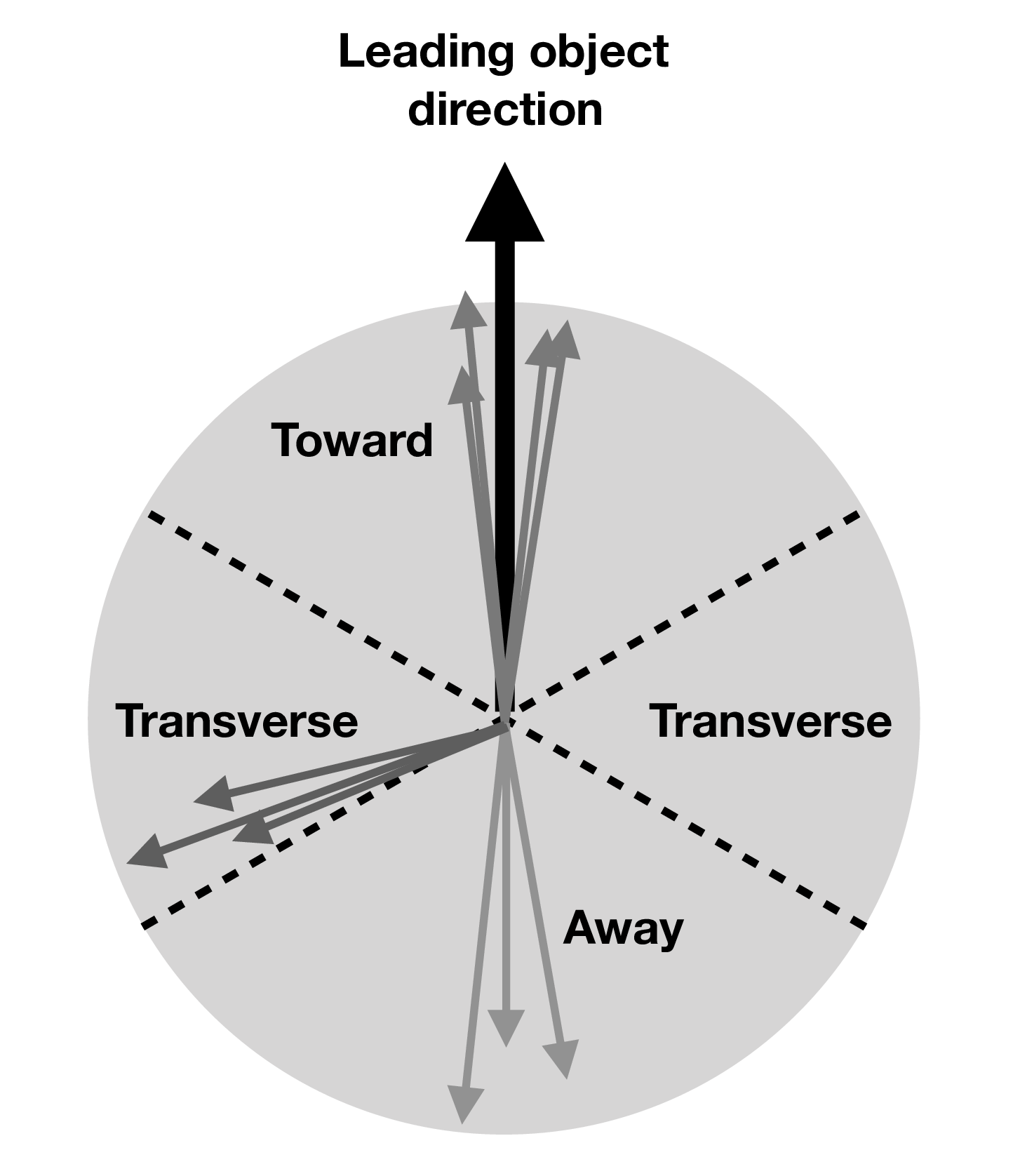
png pdf |
Figure 1:
Illustration of the different $\phi $ regions, with respect to the leading object in an event, used to probe the properties of the UE in measurements. |

png pdf |
Figure 2:
The normalized ${{\mathrm {d} N_{\mathrm{CH}}/\mathrm {d} \eta}}$ of charged hadrons as a function of $\eta $ [27]. CMS MB data are compared with SoftTune and the CH tunes. The coloured band in the ratio plot represents the total experimental uncertainty in the data. The vertical bars on the points for the different predictions represent the statistical uncertainties. |
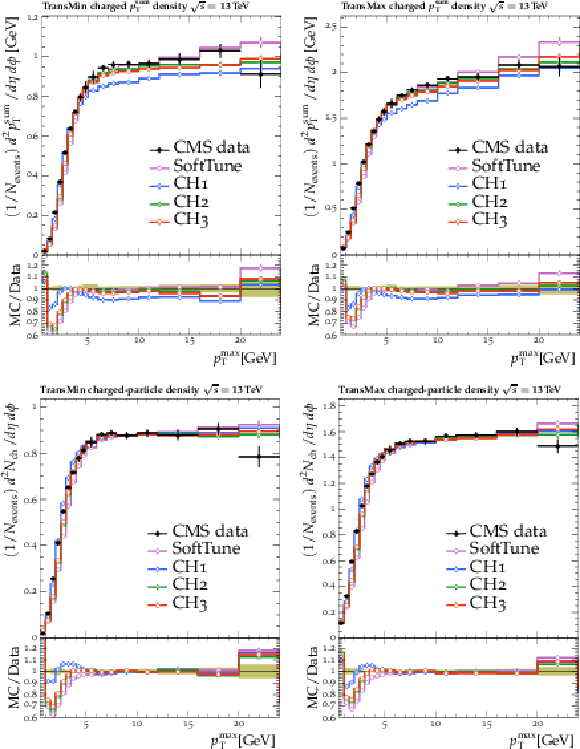
png pdf |
Figure 3:
The normalized ${{p_{\mathrm {T}}} ^{\mathrm {sum}}}$ (upper) and ${N_{\mathrm{CH}}}$ (lower) density distributions in the transMin (left) and transMax (right) regions, as a function of the ${p_{\mathrm {T}}}$ of the leading track, ${{p_{\mathrm {T}}} ^{\mathrm {max}}}$ [24]. CMS MB data are compared with the predictions from HERWIG 7, with the SoftTune and CH tunes. The coloured band in the ratio plot represents the total experimental uncertainty in the data. The vertical bars on the points for the different predictions represent the statistical uncertainties. |
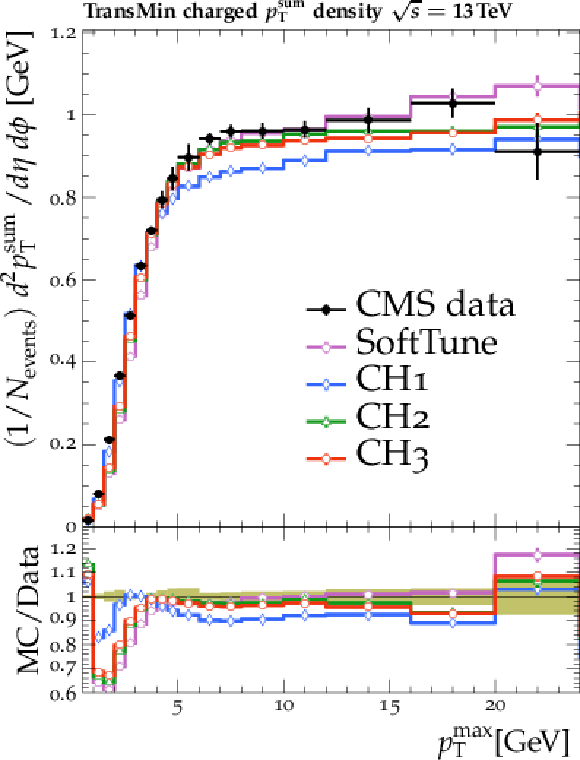
png pdf |
Figure 3-a:
The normalized ${{p_{\mathrm {T}}} ^{\mathrm {sum}}}$ density distributions in the transMin region, as a function of the ${p_{\mathrm {T}}}$ of the leading track, ${{p_{\mathrm {T}}} ^{\mathrm {max}}}$ [24]. CMS MB data are compared with the predictions from HERWIG 7, with the SoftTune and CH tunes. The coloured band in the ratio plot represents the total experimental uncertainty in the data. The vertical bars on the points for the different predictions represent the statistical uncertainties. |

png pdf |
Figure 3-b:
The normalized ${{p_{\mathrm {T}}} ^{\mathrm {sum}}}$ density distributions in the transMax region, as a function of the ${p_{\mathrm {T}}}$ of the leading track, ${{p_{\mathrm {T}}} ^{\mathrm {max}}}$ [24]. CMS MB data are compared with the predictions from HERWIG 7, with the SoftTune and CH tunes. The coloured band in the ratio plot represents the total experimental uncertainty in the data. The vertical bars on the points for the different predictions represent the statistical uncertainties. |

png pdf |
Figure 3-c:
The normalized ${N_{\mathrm{CH}}}$ density distributions in the transMin region, as a function of the ${p_{\mathrm {T}}}$ of the leading track, ${{p_{\mathrm {T}}} ^{\mathrm {max}}}$ [24]. CMS MB data are compared with the predictions from HERWIG 7, with the SoftTune and CH tunes. The coloured band in the ratio plot represents the total experimental uncertainty in the data. The vertical bars on the points for the different predictions represent the statistical uncertainties. |
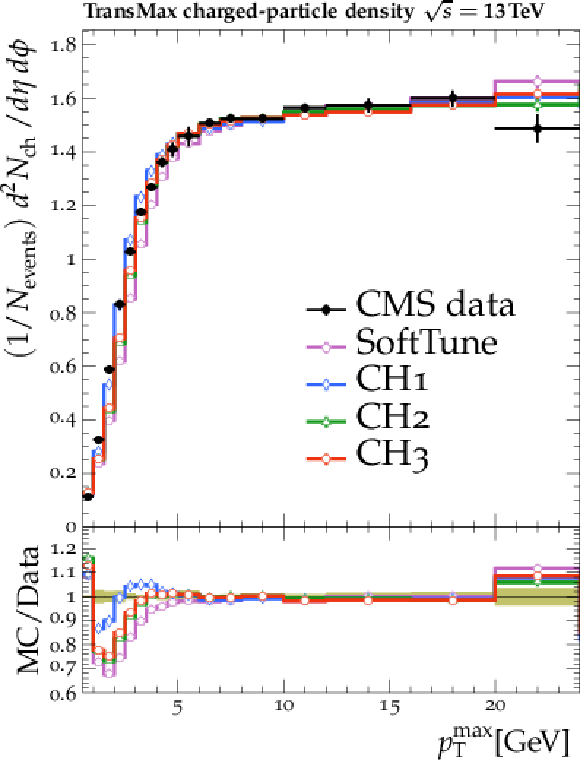
png pdf |
Figure 3-d:
The normalized ${N_{\mathrm{CH}}}$ density distributions in the transMax region, as a function of the ${p_{\mathrm {T}}}$ of the leading track, ${{p_{\mathrm {T}}} ^{\mathrm {max}}}$ [24]. CMS MB data are compared with the predictions from HERWIG 7, with the SoftTune and CH tunes. The coloured band in the ratio plot represents the total experimental uncertainty in the data. The vertical bars on the points for the different predictions represent the statistical uncertainties. |

png pdf |
Figure 4:
The ${{p_{\mathrm {T}}} ^{\mathrm {sum}}}$ (upper) and ${N_{\mathrm{CH}}}$ (lower) density distributions in the transMin (left) and transMax (right) regions, as a function of the ${p_{\mathrm {T}}}$ of the leading track, ${{p_{\mathrm {T}}} ^{\mathrm {max}}}$ [23]. CMS MB data are compared with the predictions from HERWIG 7, with the SoftTune and CH tunes. The coloured band in the ratio plot represents the total experimental uncertainty in the data. The vertical bars on the points for the different predictions represent the statistical uncertainties. |

png pdf |
Figure 4-a:
The ${{p_{\mathrm {T}}} ^{\mathrm {sum}}}$ density distributions in the transMin region, as a function of the ${p_{\mathrm {T}}}$ of the leading track, ${{p_{\mathrm {T}}} ^{\mathrm {max}}}$ [23]. CMS MB data are compared with the predictions from HERWIG 7, with the SoftTune and CH tunes. The coloured band in the ratio plot represents the total experimental uncertainty in the data. The vertical bars on the points for the different predictions represent the statistical uncertainties. |
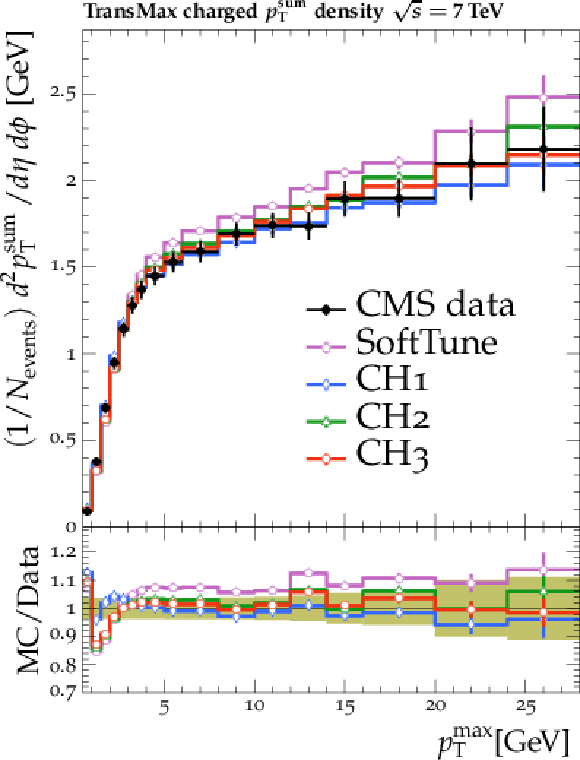
png pdf |
Figure 4-b:
The ${{p_{\mathrm {T}}} ^{\mathrm {sum}}}$ density distributions in the transMax region, as a function of the ${p_{\mathrm {T}}}$ of the leading track, ${{p_{\mathrm {T}}} ^{\mathrm {max}}}$ [23]. CMS MB data are compared with the predictions from HERWIG 7, with the SoftTune and CH tunes. The coloured band in the ratio plot represents the total experimental uncertainty in the data. The vertical bars on the points for the different predictions represent the statistical uncertainties. |

png pdf |
Figure 4-c:
The ${N_{\mathrm{CH}}}$ density distributions in the transMin region, as a function of the ${p_{\mathrm {T}}}$ of the leading track, ${{p_{\mathrm {T}}} ^{\mathrm {max}}}$ [23]. CMS MB data are compared with the predictions from HERWIG 7, with the SoftTune and CH tunes. The coloured band in the ratio plot represents the total experimental uncertainty in the data. The vertical bars on the points for the different predictions represent the statistical uncertainties. |

png pdf |
Figure 4-d:
The ${N_{\mathrm{CH}}}$ density distributions in the transMax region, as a function of the ${p_{\mathrm {T}}}$ of the leading track, ${{p_{\mathrm {T}}} ^{\mathrm {max}}}$ [23]. CMS MB data are compared with the predictions from HERWIG 7, with the SoftTune and CH tunes. The coloured band in the ratio plot represents the total experimental uncertainty in the data. The vertical bars on the points for the different predictions represent the statistical uncertainties. |
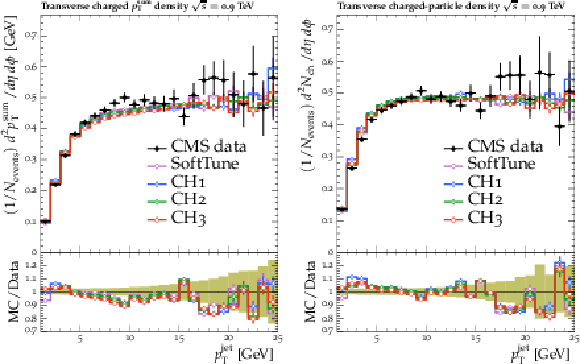
png pdf |
Figure 5:
The ${{p_{\mathrm {T}}} ^{\mathrm {sum}}}$ (left) and ${N_{\mathrm{CH}}}$ (right) density distributions in the transverse regions, as a function of the ${p_{\mathrm {T}}}$ of the leading track jet, ${{p_{\mathrm {T}}} ^{\mathrm {jet}}}$ [25]. CMS MB data are compared with the predictions from HERWIG 7, with the SoftTune and CH tunes. The coloured band in the ratio plot represents the total experimental uncertainty in the data. The vertical bars on the points for the different predictions represent the statistical uncertainties. |
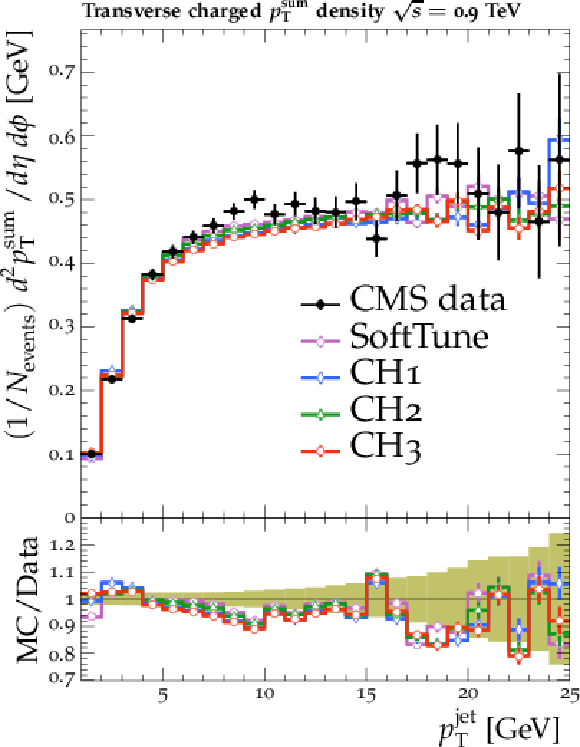
png pdf |
Figure 5-a:
The ${{p_{\mathrm {T}}} ^{\mathrm {sum}}}$ density distributions in the transverse regions, as a function of the ${p_{\mathrm {T}}}$ of the leading track jet, ${{p_{\mathrm {T}}} ^{\mathrm {jet}}}$ [25]. CMS MB data are compared with the predictions from HERWIG 7, with the SoftTune and CH tunes. The coloured band in the ratio plot represents the total experimental uncertainty in the data. The vertical bars on the points for the different predictions represent the statistical uncertainties. |
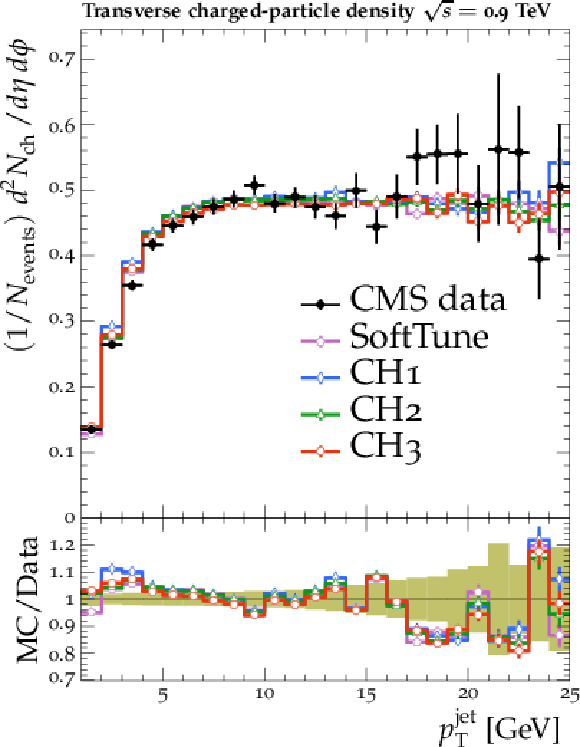
png pdf |
Figure 5-b:
The ${N_{\mathrm{CH}}}$ density distributions in the transverse regions, as a function of the ${p_{\mathrm {T}}}$ of the leading track jet, ${{p_{\mathrm {T}}} ^{\mathrm {jet}}}$ [25]. CMS MB data are compared with the predictions from HERWIG 7, with the SoftTune and CH tunes. The coloured band in the ratio plot represents the total experimental uncertainty in the data. The vertical bars on the points for the different predictions represent the statistical uncertainties. |

png pdf |
Figure 6:
The ${{p_{\mathrm {T}}} ^{\mathrm {sum}}}$ (upper) and ${N_{\mathrm{CH}}}$ (lower) density distributions in the transMin (left) and transMax (right) regions, as a function of the ${p_{\mathrm {T}}}$ of the leading track, ${{p_{\mathrm {T}}} ^{\mathrm {max}}}$ [31]. CDF MB data are compared with the predictions from HERWIG 7, with the SoftTune and CH tunes. The coloured band in the ratio plot represents the total experimental uncertainty in the data. The vertical bars on the points for the different predictions represent the statistical uncertainties. |
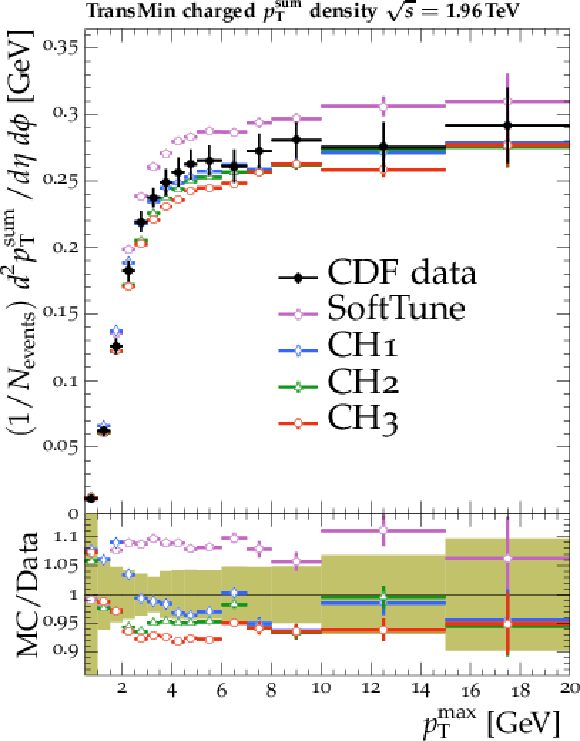
png pdf |
Figure 6-a:
The ${{p_{\mathrm {T}}} ^{\mathrm {sum}}}$ density distributions in the transMin region, as a function of the ${p_{\mathrm {T}}}$ of the leading track, ${{p_{\mathrm {T}}} ^{\mathrm {max}}}$ [31]. CDF MB data are compared with the predictions from HERWIG 7, with the SoftTune and CH tunes. The coloured band in the ratio plot represents the total experimental uncertainty in the data. The vertical bars on the points for the different predictions represent the statistical uncertainties. |
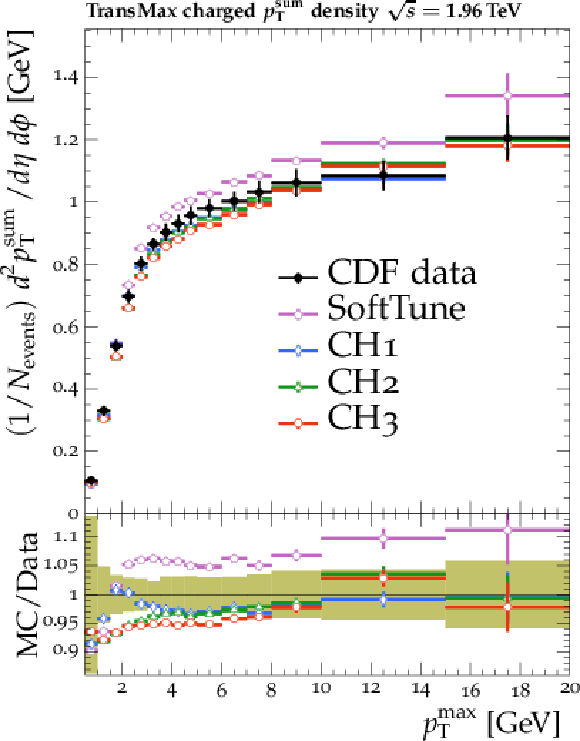
png pdf |
Figure 6-b:
The ${{p_{\mathrm {T}}} ^{\mathrm {sum}}}$ density distributions in the transMax region, as a function of the ${p_{\mathrm {T}}}$ of the leading track, ${{p_{\mathrm {T}}} ^{\mathrm {max}}}$ [31]. CDF MB data are compared with the predictions from HERWIG 7, with the SoftTune and CH tunes. The coloured band in the ratio plot represents the total experimental uncertainty in the data. The vertical bars on the points for the different predictions represent the statistical uncertainties. |

png pdf |
Figure 6-c:
The ${N_{\mathrm{CH}}}$ density distributions in the transMin region, as a function of the ${p_{\mathrm {T}}}$ of the leading track, ${{p_{\mathrm {T}}} ^{\mathrm {max}}}$ [31]. CDF MB data are compared with the predictions from HERWIG 7, with the SoftTune and CH tunes. The coloured band in the ratio plot represents the total experimental uncertainty in the data. The vertical bars on the points for the different predictions represent the statistical uncertainties. |
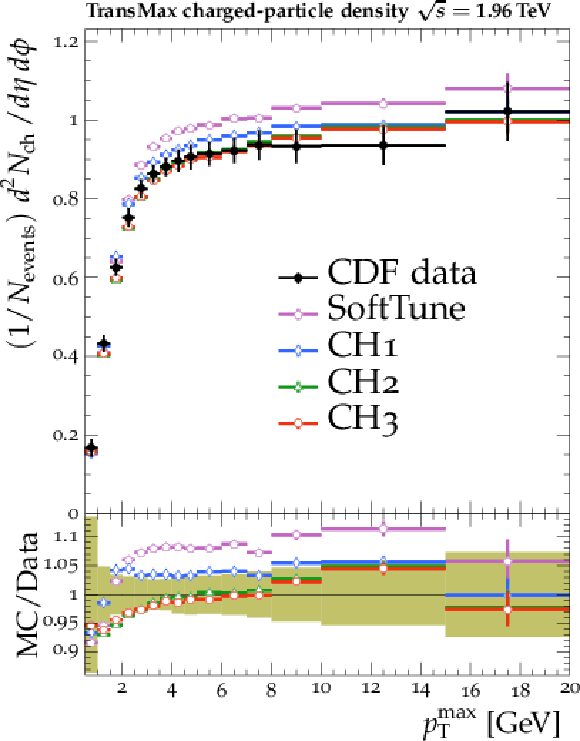
png pdf |
Figure 6-d:
The ${N_{\mathrm{CH}}}$ density distributions in the transMax region, as a function of the ${p_{\mathrm {T}}}$ of the leading track, ${{p_{\mathrm {T}}} ^{\mathrm {max}}}$ [31]. CDF MB data are compared with the predictions from HERWIG 7, with the SoftTune and CH tunes. The coloured band in the ratio plot represents the total experimental uncertainty in the data. The vertical bars on the points for the different predictions represent the statistical uncertainties. |
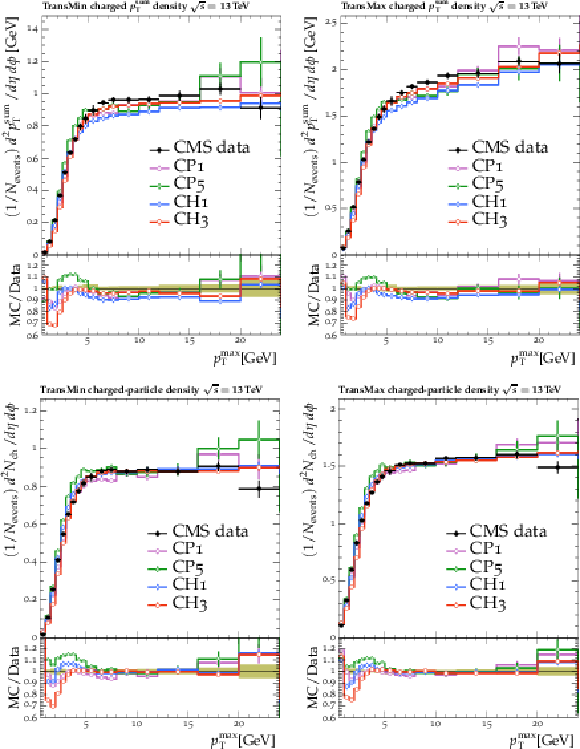
png pdf |
Figure 7:
The ${{p_{\mathrm {T}}} ^{\mathrm {sum}}}$ (upper) and ${N_{\mathrm{CH}}}$ (lower) density distributions in the transMin (left) and transMax (right) regions, as a function of the ${p_{\mathrm {T}}}$ of the leading track, ${{p_{\mathrm {T}}} ^{\mathrm {max}}}$ [24]. CMS MB data are compared with the predictions from HERWIG 7, with the CH1 and CH3 tunes, and from PYTHIA 8, with the CP1 and CP5 tunes. The coloured band in the ratio plot represents the total experimental uncertainty in the data. The vertical bars on the points for the different predictions represent the statistical uncertainties. |

png pdf |
Figure 7-a:
The ${{p_{\mathrm {T}}} ^{\mathrm {sum}}}$ density distributions in the transMin region, as a function of the ${p_{\mathrm {T}}}$ of the leading track, ${{p_{\mathrm {T}}} ^{\mathrm {max}}}$ [24]. CMS MB data are compared with the predictions from HERWIG 7, with the CH1 and CH3 tunes, and from PYTHIA 8, with the CP1 and CP5 tunes. The coloured band in the ratio plot represents the total experimental uncertainty in the data. The vertical bars on the points for the different predictions represent the statistical uncertainties. |

png pdf |
Figure 7-b:
The ${{p_{\mathrm {T}}} ^{\mathrm {sum}}}$ density distributions in the transMax region, as a function of the ${p_{\mathrm {T}}}$ of the leading track, ${{p_{\mathrm {T}}} ^{\mathrm {max}}}$ [24]. CMS MB data are compared with the predictions from HERWIG 7, with the CH1 and CH3 tunes, and from PYTHIA 8, with the CP1 and CP5 tunes. The coloured band in the ratio plot represents the total experimental uncertainty in the data. The vertical bars on the points for the different predictions represent the statistical uncertainties. |

png pdf |
Figure 7-c:
The ${N_{\mathrm{CH}}}$ density distributions in the transMin region, as a function of the ${p_{\mathrm {T}}}$ of the leading track, ${{p_{\mathrm {T}}} ^{\mathrm {max}}}$ [24]. CMS MB data are compared with the predictions from HERWIG 7, with the CH1 and CH3 tunes, and from PYTHIA 8, with the CP1 and CP5 tunes. The coloured band in the ratio plot represents the total experimental uncertainty in the data. The vertical bars on the points for the different predictions represent the statistical uncertainties. |
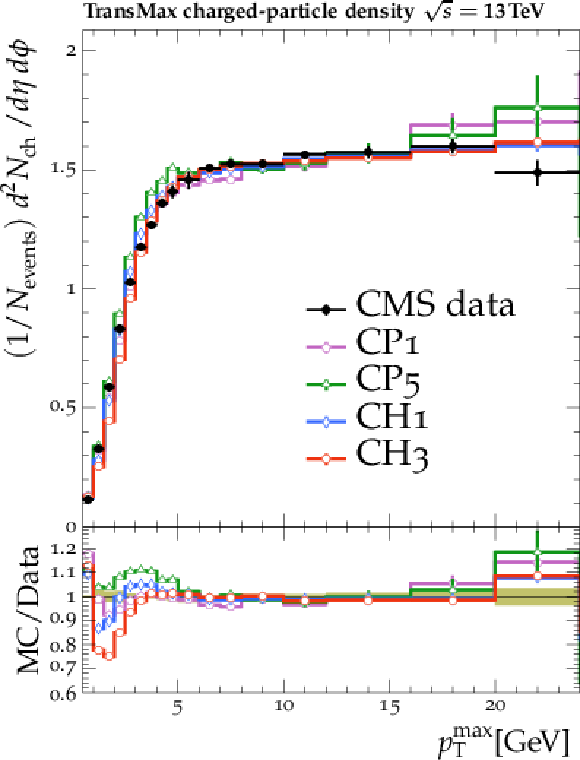
png pdf |
Figure 7-d:
The ${N_{\mathrm{CH}}}$ density distributions in the transMax region, as a function of the ${p_{\mathrm {T}}}$ of the leading track, ${{p_{\mathrm {T}}} ^{\mathrm {max}}}$ [24]. CMS MB data are compared with the predictions from HERWIG 7, with the CH1 and CH3 tunes, and from PYTHIA 8, with the CP1 and CP5 tunes. The coloured band in the ratio plot represents the total experimental uncertainty in the data. The vertical bars on the points for the different predictions represent the statistical uncertainties. |
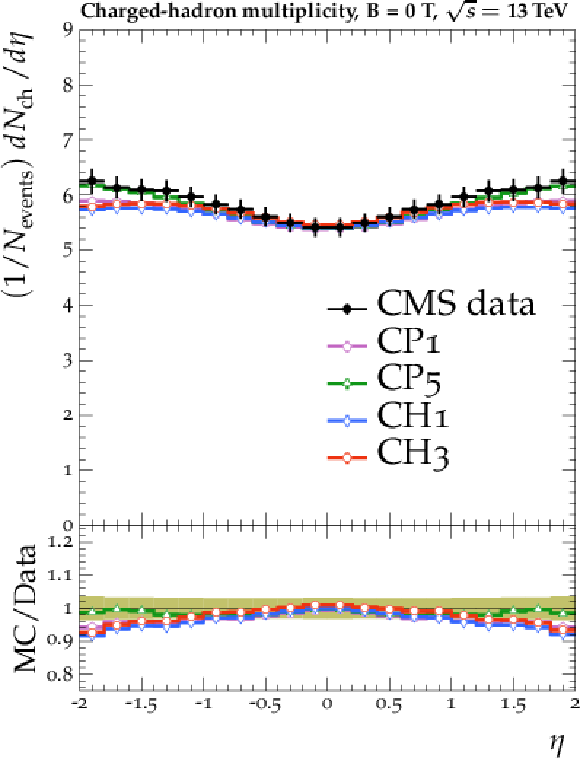
png pdf |
Figure 8:
The normalized ${{\mathrm {d} N_{\mathrm{CH}}/\mathrm {d} \eta}}$ of charged hadrons as a function of $\eta $ [27]. CMS MB data are compared with the predictions from HERWIG 7, with the CH1 and CH3 tunes, and from PYTHIA 8, with the CP1 and CP5 tunes. The coloured band in the ratio plot represents the total experimental uncertainty in the data. The vertical bars on the points for the different predictions represent the statistical uncertainties. |

png pdf |
Figure 9:
The ${{p_{\mathrm {T}}} ^{\mathrm {sum}}}$ (upper) and ${N_{\mathrm{CH}}}$ (lower) density distributions in the transMin (left) and transMax (right) regions, as a function of the ${p_{\mathrm {T}}}$ of the leading track, ${{p_{\mathrm {T}}} ^{\mathrm {max}}}$ [24]. CMS MB data are compared with the predictions from HERWIG 7, with the CH tunes. The coloured band in the ratio plot represents the total experimental uncertainty in the data. The vertical bars on the points for the different predictions represent the statistical uncertainties. The grey-shaded band corresponds to the envelope of the "up'' and "down'' variations of the CH3 tune. |

png pdf |
Figure 9-a:
The ${{p_{\mathrm {T}}} ^{\mathrm {sum}}}$ density distributions in the transMin region, as a function of the ${p_{\mathrm {T}}}$ of the leading track, ${{p_{\mathrm {T}}} ^{\mathrm {max}}}$ [24]. CMS MB data are compared with the predictions from HERWIG 7, with the CH tunes. The coloured band in the ratio plot represents the total experimental uncertainty in the data. The vertical bars on the points for the different predictions represent the statistical uncertainties. The grey-shaded band corresponds to the envelope of the "up'' and "down'' variations of the CH3 tune. |
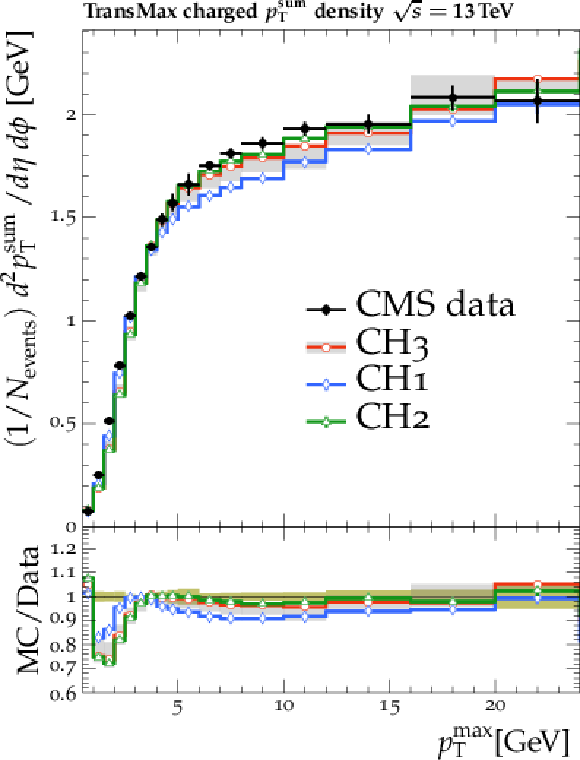
png pdf |
Figure 9-b:
The ${{p_{\mathrm {T}}} ^{\mathrm {sum}}}$ density distributions in the transMax region, as a function of the ${p_{\mathrm {T}}}$ of the leading track, ${{p_{\mathrm {T}}} ^{\mathrm {max}}}$ [24]. CMS MB data are compared with the predictions from HERWIG 7, with the CH tunes. The coloured band in the ratio plot represents the total experimental uncertainty in the data. The vertical bars on the points for the different predictions represent the statistical uncertainties. The grey-shaded band corresponds to the envelope of the "up'' and "down'' variations of the CH3 tune. |

png pdf |
Figure 9-c:
The ${N_{\mathrm{CH}}}$ density distributions in the transMin region, as a function of the ${p_{\mathrm {T}}}$ of the leading track, ${{p_{\mathrm {T}}} ^{\mathrm {max}}}$ [24]. CMS MB data are compared with the predictions from HERWIG 7, with the CH tunes. The coloured band in the ratio plot represents the total experimental uncertainty in the data. The vertical bars on the points for the different predictions represent the statistical uncertainties. The grey-shaded band corresponds to the envelope of the "up'' and "down'' variations of the CH3 tune. |
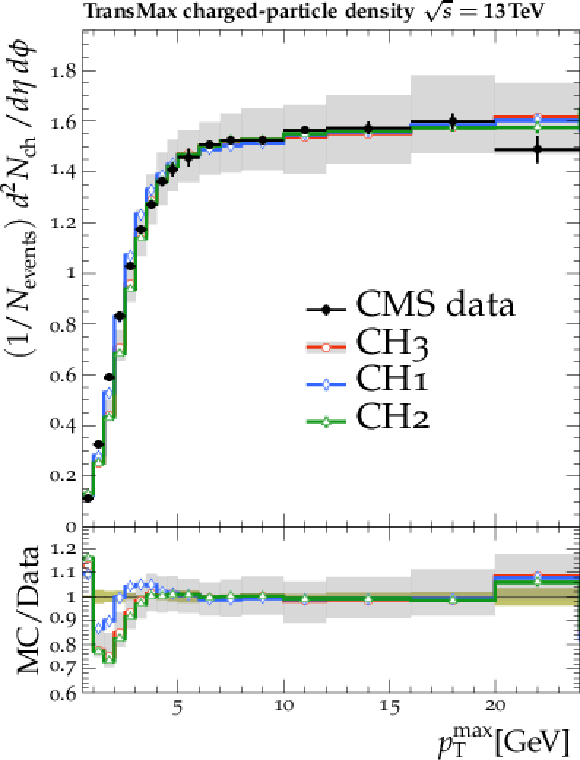
png pdf |
Figure 9-d:
The ${N_{\mathrm{CH}}}$ density distributions in the transMax region, as a function of the ${p_{\mathrm {T}}}$ of the leading track, ${{p_{\mathrm {T}}} ^{\mathrm {max}}}$ [24]. CMS MB data are compared with the predictions from HERWIG 7, with the CH tunes. The coloured band in the ratio plot represents the total experimental uncertainty in the data. The vertical bars on the points for the different predictions represent the statistical uncertainties. The grey-shaded band corresponds to the envelope of the "up'' and "down'' variations of the CH3 tune. |

png pdf |
Figure 10:
The normalized ${{\mathrm {d} N_{\mathrm{CH}}/\mathrm {d} \eta}}$ of charged hadrons as a function of $\eta $ [27]. CMS MB data are compared with the predictions from HERWIG 7, with the CH tunes. The coloured band in the ratio plot represents the total experimental uncertainty in the data. The vertical bars on the points for the different predictions represent the statistical uncertainties. The grey-shaded band corresponds to the envelope of the "up'' and "down'' variations of the CH3 tune. |
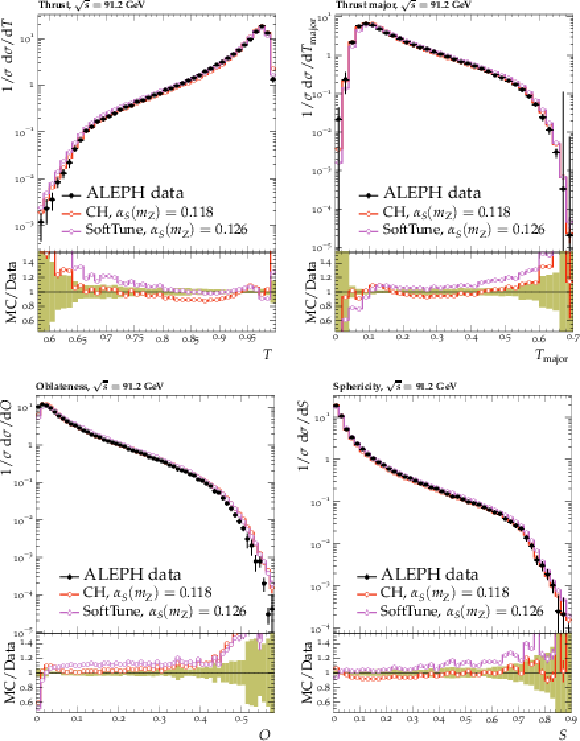
png pdf |
Figure 11:
Normalized differential cross sections for $\mathrm{e^{-}} \mathrm{e^{+}}$ [32] as a function of the variables $T$ (upper left), ${T_{\mathrm {major}}}$ (upper right), $O$ (lower left), and $S$ (lower right) for ALEPH data at $ {\sqrt {s}} = $ 91.2 GeV. ALEPH data are compared with the predictions from HERWIG 7 using the SoftTune and CH tunes. The coloured band in the ratios of the different predictions from simulation to the data represents the total experimental uncertainty in the data. |

png pdf |
Figure 11-a:
Normalized differential cross sections for $\mathrm{e^{-}} \mathrm{e^{+}}$ [32] as a function of the variable $T$ for ALEPH data at $ {\sqrt {s}} = $ 91.2 GeV. ALEPH data are compared with the predictions from HERWIG 7 using the SoftTune and CH tunes. The coloured band in the ratios of the different predictions from simulation to the data represents the total experimental uncertainty in the data. |

png pdf |
Figure 11-b:
Normalized differential cross sections for $\mathrm{e^{-}} \mathrm{e^{+}}$ [32] as a function of the variable ${T_{\mathrm {major}}}$ for ALEPH data at $ {\sqrt {s}} = $ 91.2 GeV. ALEPH data are compared with the predictions from HERWIG 7 using the SoftTune and CH tunes. The coloured band in the ratios of the different predictions from simulation to the data represents the total experimental uncertainty in the data. |
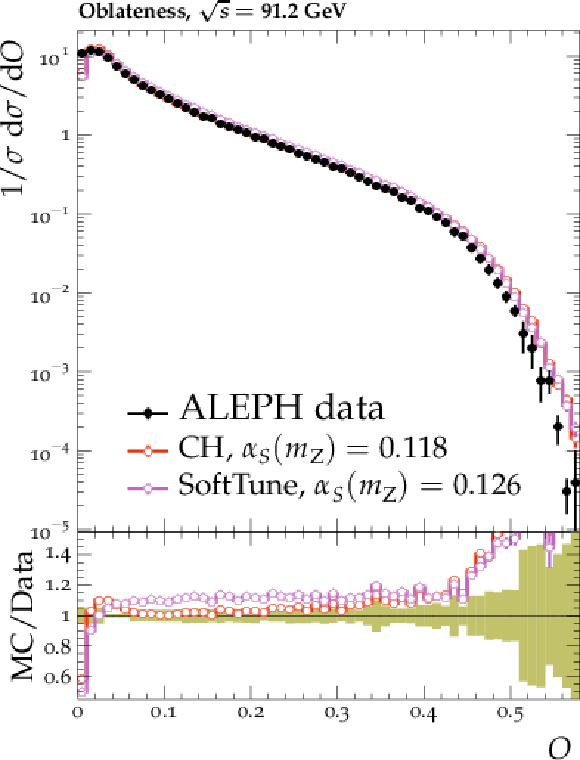
png pdf |
Figure 11-c:
Normalized differential cross sections for $\mathrm{e^{-}} \mathrm{e^{+}}$ [32] as a function of the variable $O$ for ALEPH data at $ {\sqrt {s}} = $ 91.2 GeV. ALEPH data are compared with the predictions from HERWIG 7 using the SoftTune and CH tunes. The coloured band in the ratios of the different predictions from simulation to the data represents the total experimental uncertainty in the data. |
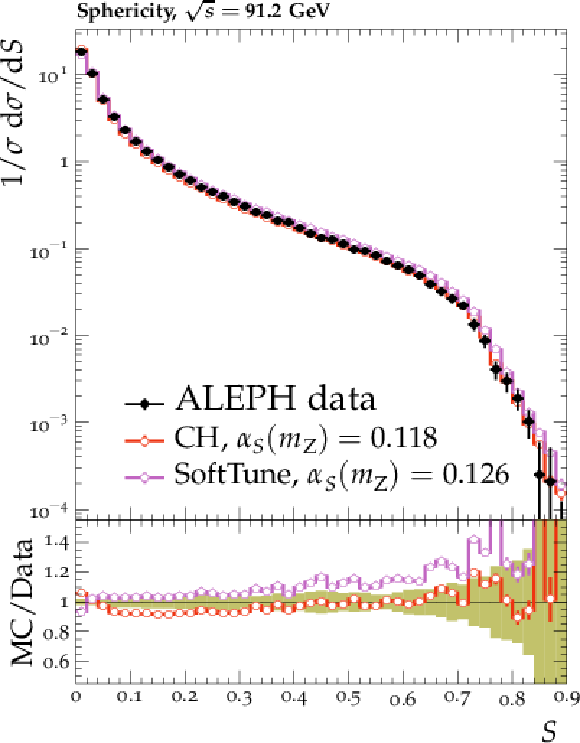
png pdf |
Figure 11-d:
Normalized differential cross sections for $\mathrm{e^{-}} \mathrm{e^{+}}$ [32] as a function of the variable $S$ for ALEPH data at $ {\sqrt {s}} = $ 91.2 GeV. ALEPH data are compared with the predictions from HERWIG 7 using the SoftTune and CH tunes. The coloured band in the ratios of the different predictions from simulation to the data represents the total experimental uncertainty in the data. |
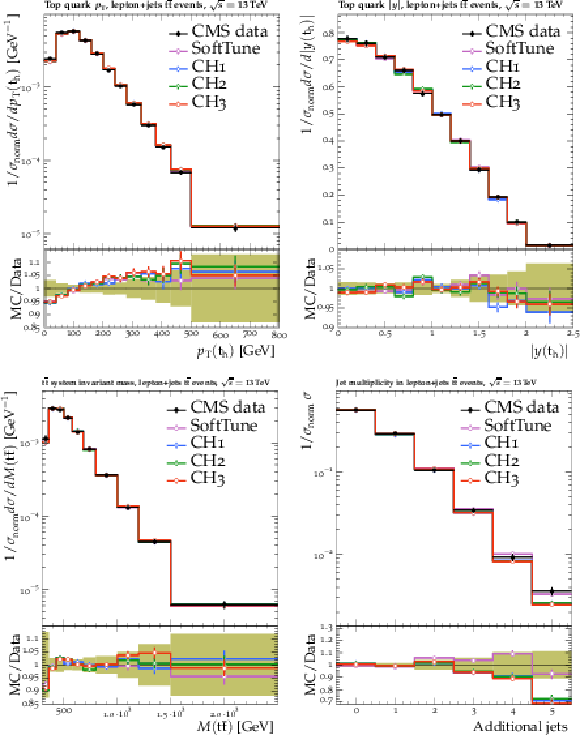
png pdf |
Figure 12:
The differential cross sections are shown as functions of: the ${p_{\mathrm {T}}}$ (upper left) and rapidity (upper right) of the hadronically decaying top quark; the invariant mass of the ${\mathrm{t} \mathrm{\bar{t}}}$ system (lower left); the additional jet multiplicity (lower right) [38]. CMS ${\mathrm{t} \mathrm{\bar{t}}}$ data are compared with the predictions from POWHEG + HERWIG 7, with the SoftTune, CH1, CH2, and CH3 tunes. The coloured band in the ratio plot represents the total experimental uncertainty in the data. The vertical bars on the points for the different predictions represent the statistical uncertainties. |

png pdf |
Figure 12-a:
The differential cross sections are shown as a function of the ${p_{\mathrm {T}}}$ [38]. CMS ${\mathrm{t} \mathrm{\bar{t}}}$ data are compared with the predictions from POWHEG + HERWIG 7, with the SoftTune, CH1, CH2, and CH3 tunes. The coloured band in the ratio plot represents the total experimental uncertainty in the data. The vertical bars on the points for the different predictions represent the statistical uncertainties. |
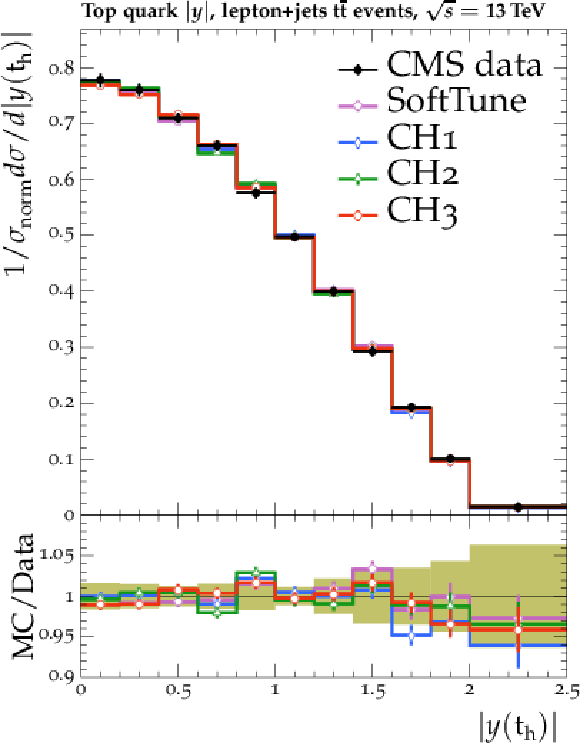
png pdf |
Figure 12-b:
The differential cross sections are shown as a function of rapidity of the hadronically decaying top quark [38]. CMS ${\mathrm{t} \mathrm{\bar{t}}}$ data are compared with the predictions from POWHEG + HERWIG 7, with the SoftTune, CH1, CH2, and CH3 tunes. The coloured band in the ratio plot represents the total experimental uncertainty in the data. The vertical bars on the points for the different predictions represent the statistical uncertainties. |

png pdf |
Figure 12-c:
The differential cross sections are shown as a function of the invariant mass of the ${\mathrm{t} \mathrm{\bar{t}}}$ system [38]. CMS ${\mathrm{t} \mathrm{\bar{t}}}$ data are compared with the predictions from POWHEG + HERWIG 7, with the SoftTune, CH1, CH2, and CH3 tunes. The coloured band in the ratio plot represents the total experimental uncertainty in the data. The vertical bars on the points for the different predictions represent the statistical uncertainties. |

png pdf |
Figure 12-d:
The differential cross sections are shown as a function of the additional jet multiplicity [38]. CMS ${\mathrm{t} \mathrm{\bar{t}}}$ data are compared with the predictions from POWHEG + HERWIG 7, with the SoftTune, CH1, CH2, and CH3 tunes. The coloured band in the ratio plot represents the total experimental uncertainty in the data. The vertical bars on the points for the different predictions represent the statistical uncertainties. |

png pdf |
Figure 13:
The differential cross sections are shown as functions of ${H_{\mathrm {T}}}$ (left) and ${{p_{\mathrm {T}}} ^\text {miss}}$ (right) [41]. CMS ${\mathrm{t} \mathrm{\bar{t}}}$ data are compared with the predictions from POWHEG + HERWIG 7, with the SoftTune, CH1, CH2, and CH3 tunes. The coloured band in the ratio plot represents the total experimental uncertainty in the data. The vertical bars on the points for the different predictions represent the statistical uncertainties. |

png pdf |
Figure 13-a:
The differential cross sections are shown as a function of ${H_{\mathrm {T}}}$ [41]. CMS ${\mathrm{t} \mathrm{\bar{t}}}$ data are compared with the predictions from POWHEG + HERWIG 7, with the SoftTune, CH1, CH2, and CH3 tunes. The coloured band in the ratio plot represents the total experimental uncertainty in the data. The vertical bars on the points for the different predictions represent the statistical uncertainties. |
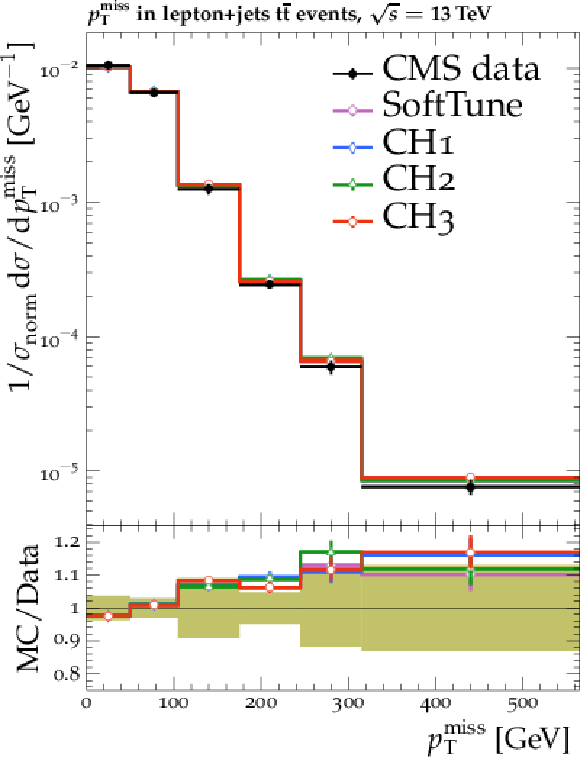
png pdf |
Figure 13-b:
The differential cross sections are shown as a function of ${{p_{\mathrm {T}}} ^\text {miss}}$ [41]. CMS ${\mathrm{t} \mathrm{\bar{t}}}$ data are compared with the predictions from POWHEG + HERWIG 7, with the SoftTune, CH1, CH2, and CH3 tunes. The coloured band in the ratio plot represents the total experimental uncertainty in the data. The vertical bars on the points for the different predictions represent the statistical uncertainties. |

png pdf |
Figure 14:
The normalized jet substructure observables in single-lepton events: the charged-particle multiplicity (upper left); the eccentricity (upper right); the groomed momentum fraction (lower left); and the angle between the groomed subjects (lower right) [42]. CMS ${\mathrm{t} \mathrm{\bar{t}}}$ data are compared with the predictions from POWHEG + HERWIG 7, with the SoftTune, CH1, CH2, and CH3 tunes. The coloured band in the ratio plot represents the total experimental uncertainty in the data. The vertical bars on the points for the different predictions represent the statistical uncertainties. |

png pdf |
Figure 14-a:
The normalized jet substructure charged-particle multiplicity observable in single-lepton events [42]. CMS ${\mathrm{t} \mathrm{\bar{t}}}$ data are compared with the predictions from POWHEG + HERWIG 7, with the SoftTune, CH1, CH2, and CH3 tunes. The coloured band in the ratio plot represents the total experimental uncertainty in the data. The vertical bars on the points for the different predictions represent the statistical uncertainties. |

png pdf |
Figure 14-b:
The normalized jet substructure eccentricity observable in single-lepton events [42]. CMS ${\mathrm{t} \mathrm{\bar{t}}}$ data are compared with the predictions from POWHEG + HERWIG 7, with the SoftTune, CH1, CH2, and CH3 tunes. The coloured band in the ratio plot represents the total experimental uncertainty in the data. The vertical bars on the points for the different predictions represent the statistical uncertainties. |
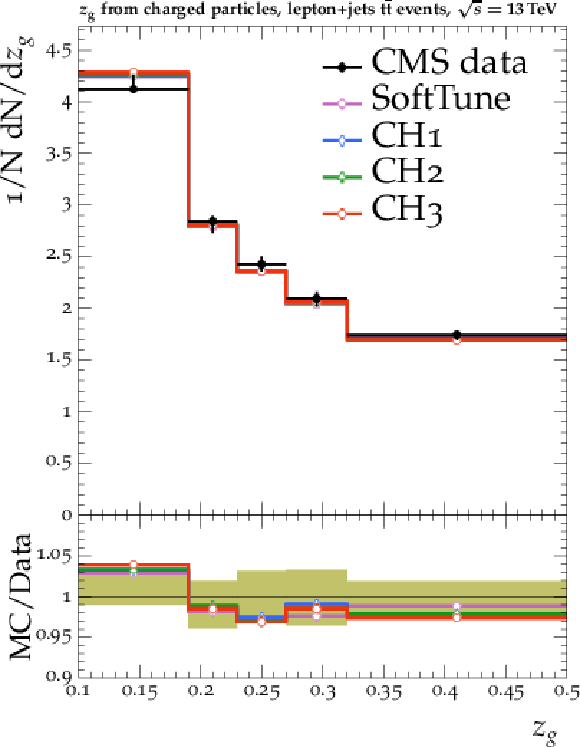
png pdf |
Figure 14-c:
The normalized jet substructure groomed momentum fraction observable in single-lepton events [42]. CMS ${\mathrm{t} \mathrm{\bar{t}}}$ data are compared with the predictions from POWHEG + HERWIG 7, with the SoftTune, CH1, CH2, and CH3 tunes. The coloured band in the ratio plot represents the total experimental uncertainty in the data. The vertical bars on the points for the different predictions represent the statistical uncertainties. |
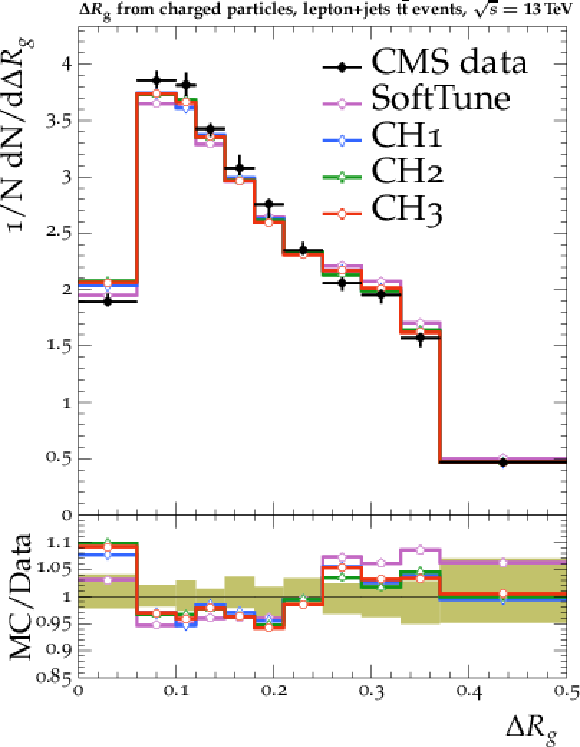
png pdf |
Figure 14-d:
The normalized jet substructure angle between the groomed subjects observable in single-lepton events [42]. CMS ${\mathrm{t} \mathrm{\bar{t}}}$ data are compared with the predictions from POWHEG + HERWIG 7, with the SoftTune, CH1, CH2, and CH3 tunes. The coloured band in the ratio plot represents the total experimental uncertainty in the data. The vertical bars on the points for the different predictions represent the statistical uncertainties. |
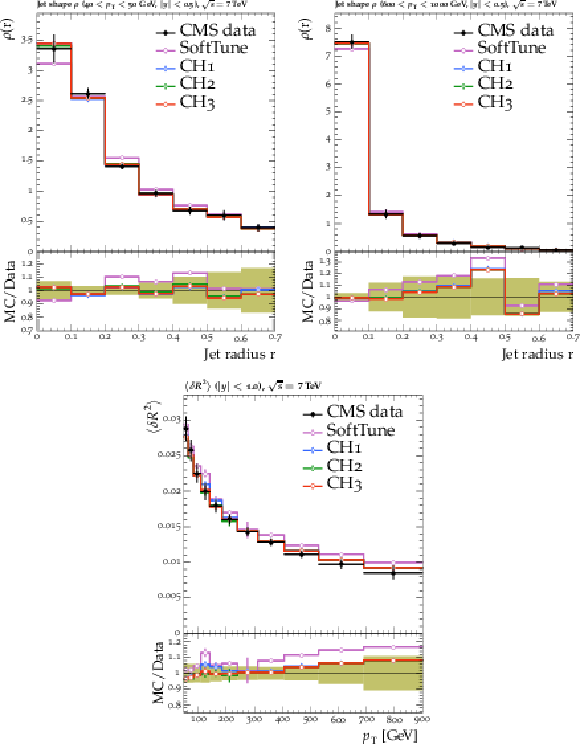
png pdf |
Figure 15:
The differential jet shape ${\rho (\mathrm {r})}$ (upper left and right) and the second moment of the jet transverse width $< \delta R^2 >$ in inclusive jet events [43]. CMS inclusive jet data are compared with the predictions from HERWIG 7, with the SoftTune and CH tunes. The coloured band in the ratio plot represents the total experimental uncertainty in the data. The vertical bars on the points for the different predictions represent the statistical uncertainties. |
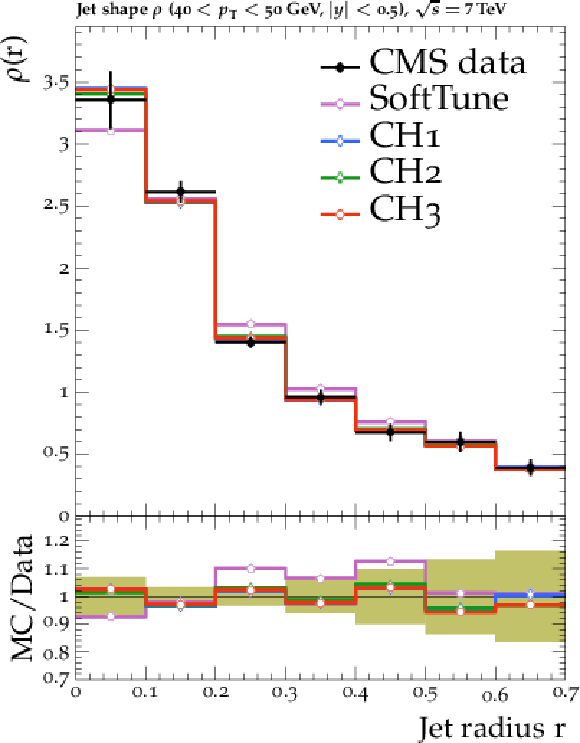
png pdf |
Figure 15-a:
The differential jet shape ${\rho (\mathrm {r})}$ (upper left and right) and the second moment of the jet transverse width $< \delta R^2 >$ in inclusive jet events [43]. CMS inclusive jet data are compared with the predictions from HERWIG 7, with the SoftTune and CH tunes. The coloured band in the ratio plot represents the total experimental uncertainty in the data. The vertical bars on the points for the different predictions represent the statistical uncertainties. |
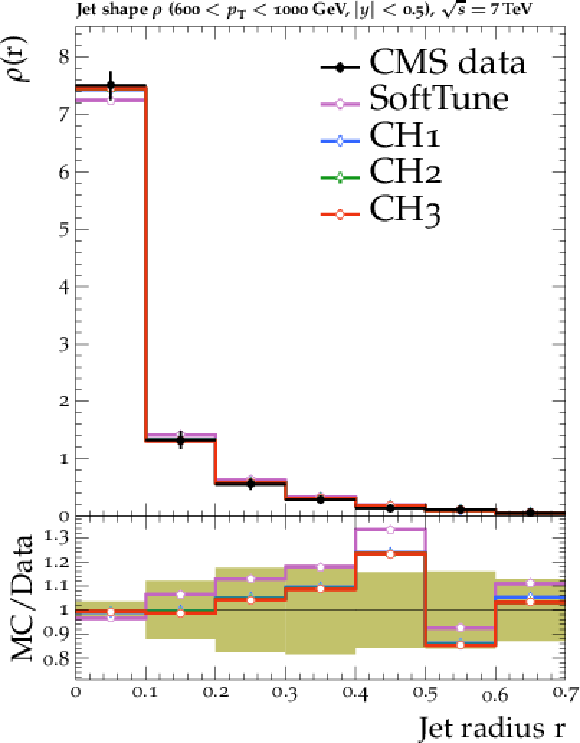
png pdf |
Figure 15-b:
The differential jet shape ${\rho (\mathrm {r})}$ (upper left and right) and the second moment of the jet transverse width $< \delta R^2 >$ in inclusive jet events [43]. CMS inclusive jet data are compared with the predictions from HERWIG 7, with the SoftTune and CH tunes. The coloured band in the ratio plot represents the total experimental uncertainty in the data. The vertical bars on the points for the different predictions represent the statistical uncertainties. |
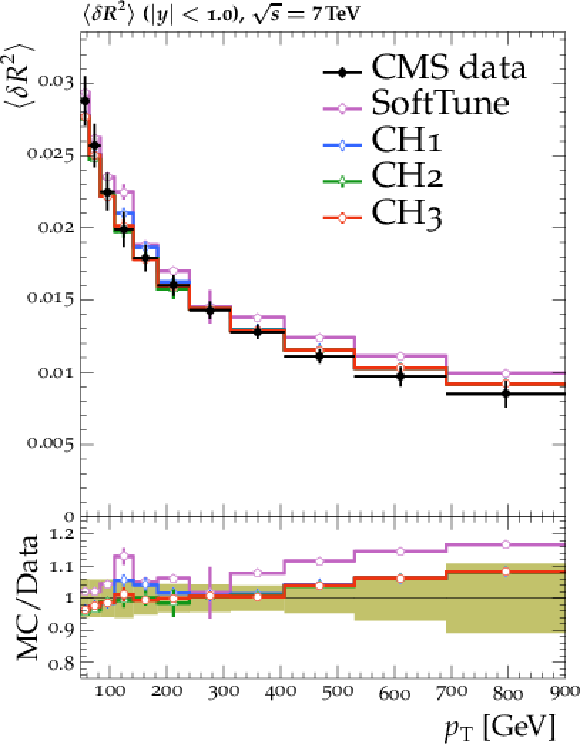
png pdf |
Figure 15-c:
The differential jet shape ${\rho (\mathrm {r})}$ (upper left and right) and the second moment of the jet transverse width $< \delta R^2 >$ in inclusive jet events [43]. CMS inclusive jet data are compared with the predictions from HERWIG 7, with the SoftTune and CH tunes. The coloured band in the ratio plot represents the total experimental uncertainty in the data. The vertical bars on the points for the different predictions represent the statistical uncertainties. |

png pdf |
Figure 16:
The ${{p_{\mathrm {T}}} ^{\mathrm {sum}}}$ (left) and ${N_{\mathrm{CH}}}$ (right) density distributions in the transverse region, as a function of the ${p_{\mathrm {T}}}$ of the two muons, ${{p_{\mathrm {T}}} (\mu \mu)}$ [45]. The transverse region is defined with respect to ${{p_{\mathrm {T}}} (\mu \mu)}$, where the two muons are required to have an invariant mass close the the mass of the Z boson. CMS Z boson data are compared with the predictions from MadGraph 5\_aMC@NLO + HERWIG 7, with the SoftTune and CH tunes. The coloured band in the ratio plot represents the total experimental uncertainty in the data. The vertical bars on the points for the different predictions represent the statistical uncertainties. |

png pdf |
Figure 16-a:
The ${{p_{\mathrm {T}}} ^{\mathrm {sum}}}$ (left) and ${N_{\mathrm{CH}}}$ (right) density distributions in the transverse region, as a function of the ${p_{\mathrm {T}}}$ of the two muons, ${{p_{\mathrm {T}}} (\mu \mu)}$ [45]. The transverse region is defined with respect to ${{p_{\mathrm {T}}} (\mu \mu)}$, where the two muons are required to have an invariant mass close the the mass of the Z boson. CMS Z boson data are compared with the predictions from MadGraph 5\_aMC@NLO + HERWIG 7, with the SoftTune and CH tunes. The coloured band in the ratio plot represents the total experimental uncertainty in the data. The vertical bars on the points for the different predictions represent the statistical uncertainties. |

png pdf |
Figure 16-b:
The ${{p_{\mathrm {T}}} ^{\mathrm {sum}}}$ (left) and ${N_{\mathrm{CH}}}$ (right) density distributions in the transverse region, as a function of the ${p_{\mathrm {T}}}$ of the two muons, ${{p_{\mathrm {T}}} (\mu \mu)}$ [45]. The transverse region is defined with respect to ${{p_{\mathrm {T}}} (\mu \mu)}$, where the two muons are required to have an invariant mass close the the mass of the Z boson. CMS Z boson data are compared with the predictions from MadGraph 5\_aMC@NLO + HERWIG 7, with the SoftTune and CH tunes. The coloured band in the ratio plot represents the total experimental uncertainty in the data. The vertical bars on the points for the different predictions represent the statistical uncertainties. |

png pdf |
Figure 17:
The ${{p_{\mathrm {T}}} ^{\mathrm {sum}}}$ (left) and ${N_{\mathrm{CH}}}$ (right) density distributions in the toward (upper), and away (lower) regions, as a function of the ${p_{\mathrm {T}}}$ of the two muons, ${{p_{\mathrm {T}}} (\mu \mu)}$ [45]. The toward and away regions are defined with respect to ${{p_{\mathrm {T}}} (\mu \mu)}$, where the two muons are required to have an invariant mass close the the mass of the Z boson. CMS Z boson data are compared with the predictions from MadGraph 5\_aMC@NLO + HERWIG 7, with the SoftTune and CH tunes. The coloured band in the ratio plot represents the total experimental uncertainty in the data. The vertical bars on the points for the different predictions represent the statistical uncertainties. |
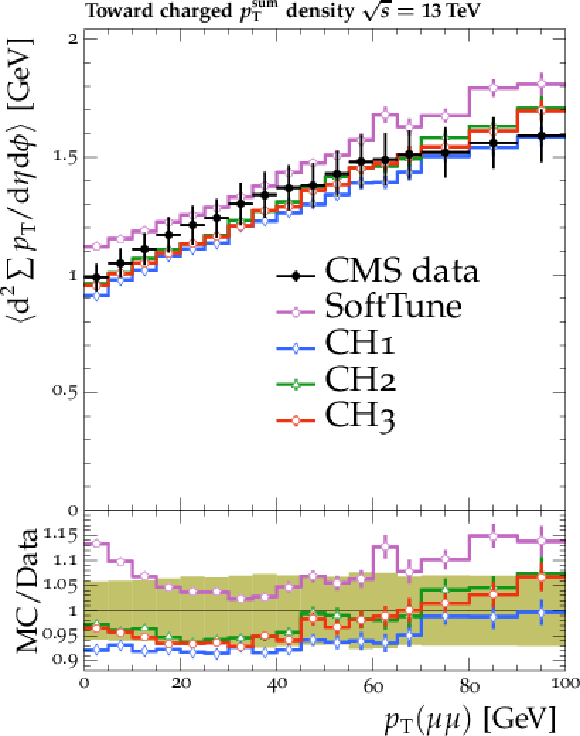
png pdf |
Figure 17-a:
The ${{p_{\mathrm {T}}} ^{\mathrm {sum}}}$ (left) and ${N_{\mathrm{CH}}}$ (right) density distributions in the toward (upper), and away (lower) regions, as a function of the ${p_{\mathrm {T}}}$ of the two muons, ${{p_{\mathrm {T}}} (\mu \mu)}$ [45]. The toward and away regions are defined with respect to ${{p_{\mathrm {T}}} (\mu \mu)}$, where the two muons are required to have an invariant mass close the the mass of the Z boson. CMS Z boson data are compared with the predictions from MadGraph 5\_aMC@NLO + HERWIG 7, with the SoftTune and CH tunes. The coloured band in the ratio plot represents the total experimental uncertainty in the data. The vertical bars on the points for the different predictions represent the statistical uncertainties. |
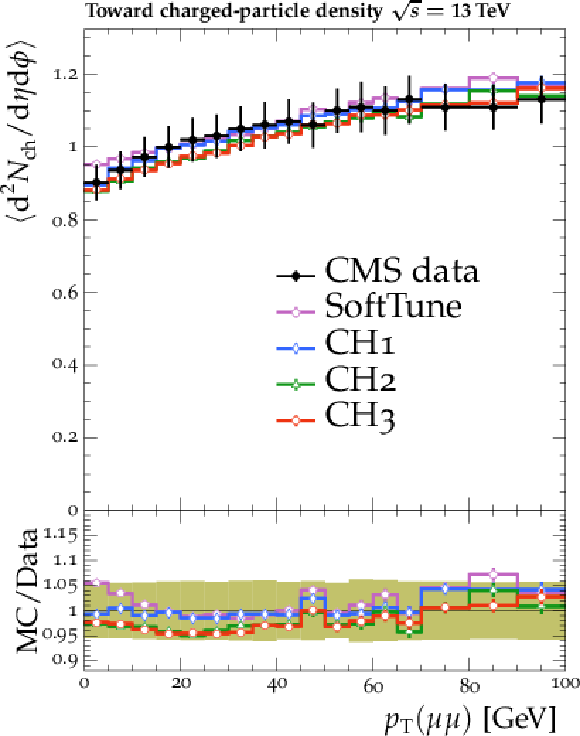
png pdf |
Figure 17-b:
The ${{p_{\mathrm {T}}} ^{\mathrm {sum}}}$ (left) and ${N_{\mathrm{CH}}}$ (right) density distributions in the toward (upper), and away (lower) regions, as a function of the ${p_{\mathrm {T}}}$ of the two muons, ${{p_{\mathrm {T}}} (\mu \mu)}$ [45]. The toward and away regions are defined with respect to ${{p_{\mathrm {T}}} (\mu \mu)}$, where the two muons are required to have an invariant mass close the the mass of the Z boson. CMS Z boson data are compared with the predictions from MadGraph 5\_aMC@NLO + HERWIG 7, with the SoftTune and CH tunes. The coloured band in the ratio plot represents the total experimental uncertainty in the data. The vertical bars on the points for the different predictions represent the statistical uncertainties. |
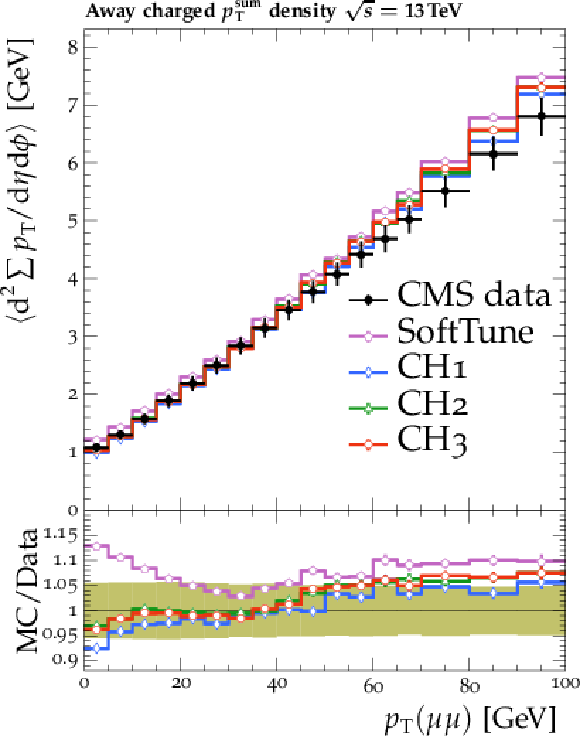
png pdf |
Figure 17-c:
The ${{p_{\mathrm {T}}} ^{\mathrm {sum}}}$ (left) and ${N_{\mathrm{CH}}}$ (right) density distributions in the toward (upper), and away (lower) regions, as a function of the ${p_{\mathrm {T}}}$ of the two muons, ${{p_{\mathrm {T}}} (\mu \mu)}$ [45]. The toward and away regions are defined with respect to ${{p_{\mathrm {T}}} (\mu \mu)}$, where the two muons are required to have an invariant mass close the the mass of the Z boson. CMS Z boson data are compared with the predictions from MadGraph 5\_aMC@NLO + HERWIG 7, with the SoftTune and CH tunes. The coloured band in the ratio plot represents the total experimental uncertainty in the data. The vertical bars on the points for the different predictions represent the statistical uncertainties. |

png pdf |
Figure 17-d:
The ${{p_{\mathrm {T}}} ^{\mathrm {sum}}}$ (left) and ${N_{\mathrm{CH}}}$ (right) density distributions in the toward (upper), and away (lower) regions, as a function of the ${p_{\mathrm {T}}}$ of the two muons, ${{p_{\mathrm {T}}} (\mu \mu)}$ [45]. The toward and away regions are defined with respect to ${{p_{\mathrm {T}}} (\mu \mu)}$, where the two muons are required to have an invariant mass close the the mass of the Z boson. CMS Z boson data are compared with the predictions from MadGraph 5\_aMC@NLO + HERWIG 7, with the SoftTune and CH tunes. The coloured band in the ratio plot represents the total experimental uncertainty in the data. The vertical bars on the points for the different predictions represent the statistical uncertainties. |

png pdf |
Figure 18:
The exclusive jet multiplicity in Z (left) and W (right) boson events, measured by CMS at $ {\sqrt {s}} = $ 13 TeV [46,47]. CMS Z boson and W boson data are compared with the predictions from MadGraph 5\_aMC@NLO + HERWIG 7, with the SoftTune and CH tunes. The coloured band in the ratio plot represents the total experimental uncertainty in the data. The vertical bars on the points for the different predictions represent the statistical uncertainties. |

png pdf |
Figure 18-a:
The exclusive jet multiplicity in Z (left) and W (right) boson events, measured by CMS at $ {\sqrt {s}} = $ 13 TeV [46,47]. CMS Z boson and W boson data are compared with the predictions from MadGraph 5\_aMC@NLO + HERWIG 7, with the SoftTune and CH tunes. The coloured band in the ratio plot represents the total experimental uncertainty in the data. The vertical bars on the points for the different predictions represent the statistical uncertainties. |
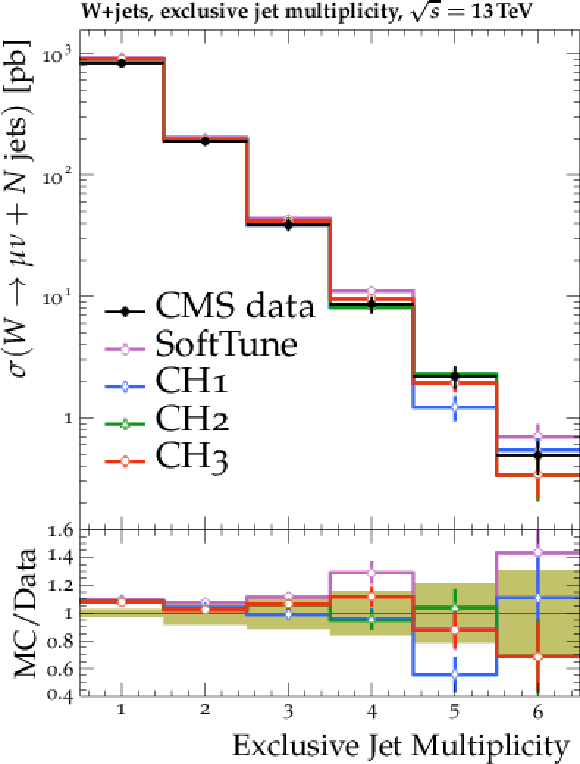
png pdf |
Figure 18-b:
The exclusive jet multiplicity in Z (left) and W (right) boson events, measured by CMS at $ {\sqrt {s}} = $ 13 TeV [46,47]. CMS Z boson and W boson data are compared with the predictions from MadGraph 5\_aMC@NLO + HERWIG 7, with the SoftTune and CH tunes. The coloured band in the ratio plot represents the total experimental uncertainty in the data. The vertical bars on the points for the different predictions represent the statistical uncertainties. |

png pdf |
Figure 19:
Differential cross sections as a function of ${{p_{\mathrm {T}}} (\mathrm{Z})}$ (upper left), ${{p_{\mathrm {T}}} ^{\mathrm {bal}}}$ (upper right), and JZB (lower) [46]. CMS Z boson data are compared with the predictions from MadGraph 5\_aMC@NLO + HERWIG 7, with the SoftTune and CH tunes. The coloured band in the ratio plot represents the total experimental uncertainty in the data. The vertical bars on the points for the different predictions represent the statistical uncertainties. |

png pdf |
Figure 19-a:
Differential cross sections as a function of ${{p_{\mathrm {T}}} (\mathrm{Z})}$ (upper left), ${{p_{\mathrm {T}}} ^{\mathrm {bal}}}$ (upper right), and JZB (lower) [46]. CMS Z boson data are compared with the predictions from MadGraph 5\_aMC@NLO + HERWIG 7, with the SoftTune and CH tunes. The coloured band in the ratio plot represents the total experimental uncertainty in the data. The vertical bars on the points for the different predictions represent the statistical uncertainties. |
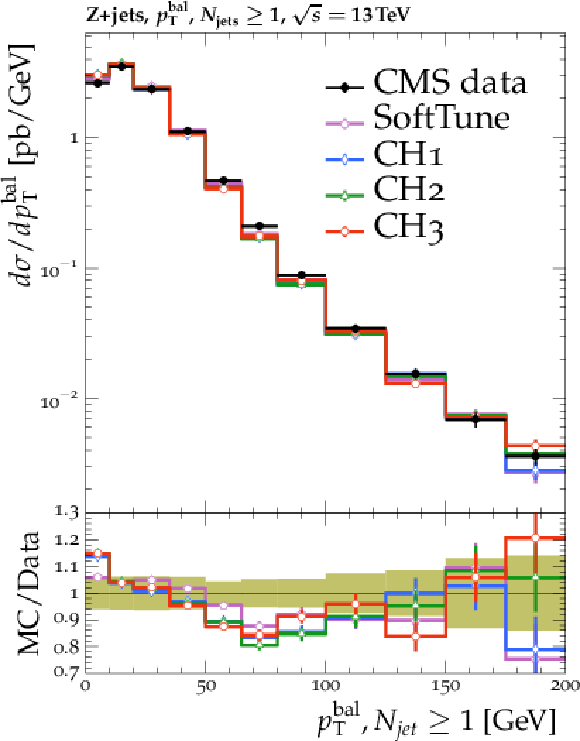
png pdf |
Figure 19-b:
Differential cross sections as a function of ${{p_{\mathrm {T}}} (\mathrm{Z})}$ (upper left), ${{p_{\mathrm {T}}} ^{\mathrm {bal}}}$ (upper right), and JZB (lower) [46]. CMS Z boson data are compared with the predictions from MadGraph 5\_aMC@NLO + HERWIG 7, with the SoftTune and CH tunes. The coloured band in the ratio plot represents the total experimental uncertainty in the data. The vertical bars on the points for the different predictions represent the statistical uncertainties. |
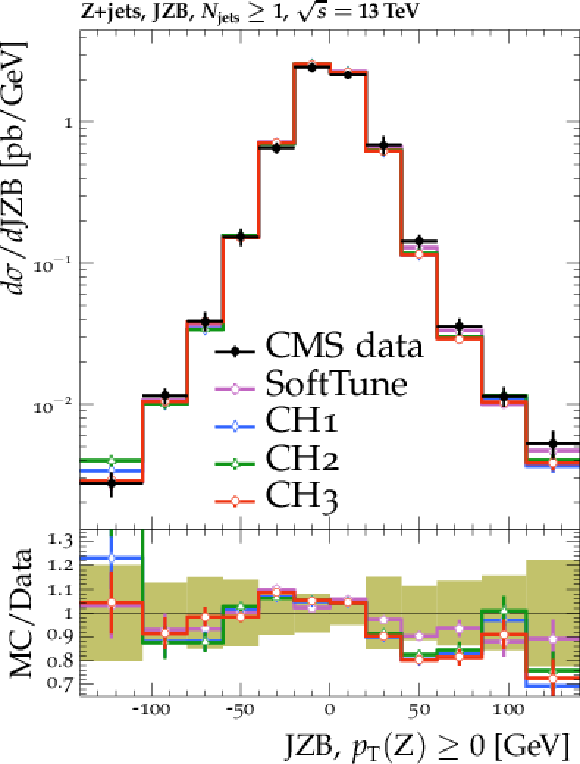
png pdf |
Figure 19-c:
Differential cross sections as a function of ${{p_{\mathrm {T}}} (\mathrm{Z})}$ (upper left), ${{p_{\mathrm {T}}} ^{\mathrm {bal}}}$ (upper right), and JZB (lower) [46]. CMS Z boson data are compared with the predictions from MadGraph 5\_aMC@NLO + HERWIG 7, with the SoftTune and CH tunes. The coloured band in the ratio plot represents the total experimental uncertainty in the data. The vertical bars on the points for the different predictions represent the statistical uncertainties. |
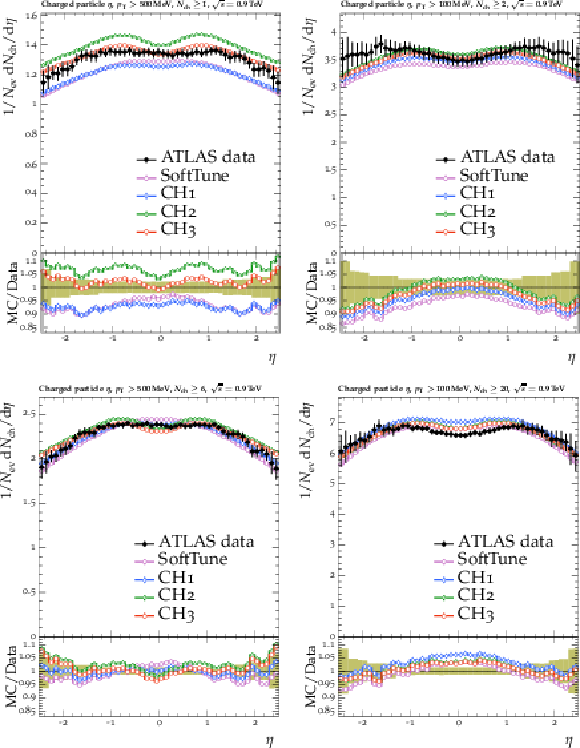
png pdf |
Figure 20:
Normalized plots [48] for the pseudorapidity of charged particles for $ {N_{\mathrm{CH}}} \ge $ 1 (upper left), and $ {N_{\mathrm{CH}}} \ge $ 6 (lower left), for charged particles with $ {p_{\mathrm {T}}} > $ 500 MeV. The figure on the upper right shows a similar distribution for $ {N_{\mathrm{CH}}} \ge $ 2, and the lower right for $ {N_{\mathrm{CH}}} \ge $ 20, where the charged particles have $ {p_{\mathrm {T}}} > $ 100 MeV. ATLAS MB data are compared with the predictions from HERWIG 7, with the SoftTune and CH tunes. The coloured band in the ratio plot represents the total experimental uncertainty in the data. The vertical bars on the points for the different predictions represent the statistical uncertainties. |

png pdf |
Figure 20-a:
Normalized plots [48] for the pseudorapidity of charged particles for $ {N_{\mathrm{CH}}} \ge $ 1 (upper left), and $ {N_{\mathrm{CH}}} \ge $ 6 (lower left), for charged particles with $ {p_{\mathrm {T}}} > $ 500 MeV. The figure on the upper right shows a similar distribution for $ {N_{\mathrm{CH}}} \ge $ 2, and the lower right for $ {N_{\mathrm{CH}}} \ge $ 20, where the charged particles have $ {p_{\mathrm {T}}} > $ 100 MeV. ATLAS MB data are compared with the predictions from HERWIG 7, with the SoftTune and CH tunes. The coloured band in the ratio plot represents the total experimental uncertainty in the data. The vertical bars on the points for the different predictions represent the statistical uncertainties. |
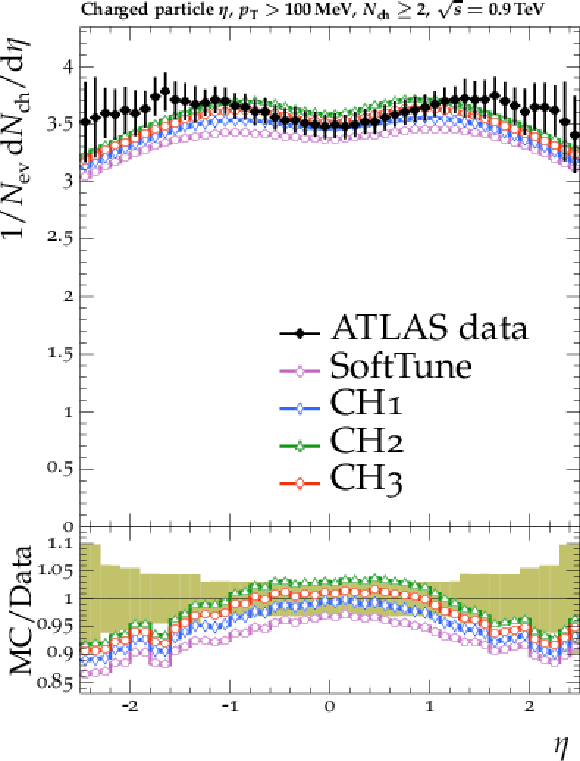
png pdf |
Figure 20-b:
Normalized plots [48] for the pseudorapidity of charged particles for $ {N_{\mathrm{CH}}} \ge $ 1 (upper left), and $ {N_{\mathrm{CH}}} \ge $ 6 (lower left), for charged particles with $ {p_{\mathrm {T}}} > $ 500 MeV. The figure on the upper right shows a similar distribution for $ {N_{\mathrm{CH}}} \ge $ 2, and the lower right for $ {N_{\mathrm{CH}}} \ge $ 20, where the charged particles have $ {p_{\mathrm {T}}} > $ 100 MeV. ATLAS MB data are compared with the predictions from HERWIG 7, with the SoftTune and CH tunes. The coloured band in the ratio plot represents the total experimental uncertainty in the data. The vertical bars on the points for the different predictions represent the statistical uncertainties. |

png pdf |
Figure 20-c:
Normalized plots [48] for the pseudorapidity of charged particles for $ {N_{\mathrm{CH}}} \ge $ 1 (upper left), and $ {N_{\mathrm{CH}}} \ge $ 6 (lower left), for charged particles with $ {p_{\mathrm {T}}} > $ 500 MeV. The figure on the upper right shows a similar distribution for $ {N_{\mathrm{CH}}} \ge $ 2, and the lower right for $ {N_{\mathrm{CH}}} \ge $ 20, where the charged particles have $ {p_{\mathrm {T}}} > $ 100 MeV. ATLAS MB data are compared with the predictions from HERWIG 7, with the SoftTune and CH tunes. The coloured band in the ratio plot represents the total experimental uncertainty in the data. The vertical bars on the points for the different predictions represent the statistical uncertainties. |

png pdf |
Figure 20-d:
Normalized plots [48] for the pseudorapidity of charged particles for $ {N_{\mathrm{CH}}} \ge $ 1 (upper left), and $ {N_{\mathrm{CH}}} \ge $ 6 (lower left), for charged particles with $ {p_{\mathrm {T}}} > $ 500 MeV. The figure on the upper right shows a similar distribution for $ {N_{\mathrm{CH}}} \ge $ 2, and the lower right for $ {N_{\mathrm{CH}}} \ge $ 20, where the charged particles have $ {p_{\mathrm {T}}} > $ 100 MeV. ATLAS MB data are compared with the predictions from HERWIG 7, with the SoftTune and CH tunes. The coloured band in the ratio plot represents the total experimental uncertainty in the data. The vertical bars on the points for the different predictions represent the statistical uncertainties. |

png pdf |
Figure 21:
Normalized plots [48] for the pseudorapidity of charged particles for $ {N_{\mathrm{CH}}} \ge $ 1 (upper left), and $ {N_{\mathrm{CH}}} \ge $ 6 (lower left), for charged particles with $ {p_{\mathrm {T}}} > $ 500 MeV. The figure on the upper right shows a similar distribution for $ {N_{\mathrm{CH}}} \ge $ 2, and the lower right for $ {N_{\mathrm{CH}}} \ge $ 20, where the charged particles have $ {p_{\mathrm {T}}} > $ 100 MeV. ATLAS MB data are compared with the predictions from HERWIG 7, with the SoftTune and CH tunes. The coloured band in the ratio plot represents the total experimental uncertainty in the data. The vertical bars on the points for the different predictions represent the statistical uncertainties. |

png pdf |
Figure 21-a:
Normalized plots [48] for the pseudorapidity of charged particles for $ {N_{\mathrm{CH}}} \ge $ 1 (upper left), and $ {N_{\mathrm{CH}}} \ge $ 6 (lower left), for charged particles with $ {p_{\mathrm {T}}} > $ 500 MeV. The figure on the upper right shows a similar distribution for $ {N_{\mathrm{CH}}} \ge $ 2, and the lower right for $ {N_{\mathrm{CH}}} \ge $ 20, where the charged particles have $ {p_{\mathrm {T}}} > $ 100 MeV. ATLAS MB data are compared with the predictions from HERWIG 7, with the SoftTune and CH tunes. The coloured band in the ratio plot represents the total experimental uncertainty in the data. The vertical bars on the points for the different predictions represent the statistical uncertainties. |

png pdf |
Figure 21-b:
Normalized plots [48] for the pseudorapidity of charged particles for $ {N_{\mathrm{CH}}} \ge $ 1 (upper left), and $ {N_{\mathrm{CH}}} \ge $ 6 (lower left), for charged particles with $ {p_{\mathrm {T}}} > $ 500 MeV. The figure on the upper right shows a similar distribution for $ {N_{\mathrm{CH}}} \ge $ 2, and the lower right for $ {N_{\mathrm{CH}}} \ge $ 20, where the charged particles have $ {p_{\mathrm {T}}} > $ 100 MeV. ATLAS MB data are compared with the predictions from HERWIG 7, with the SoftTune and CH tunes. The coloured band in the ratio plot represents the total experimental uncertainty in the data. The vertical bars on the points for the different predictions represent the statistical uncertainties. |
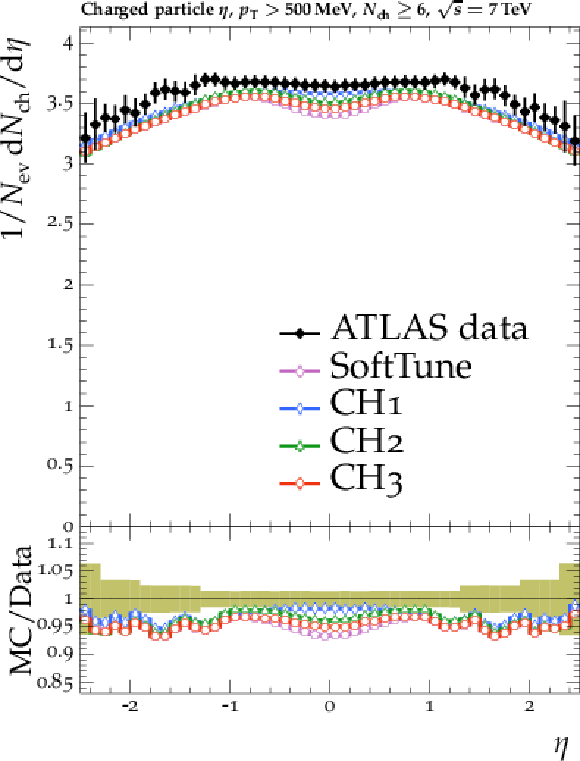
png pdf |
Figure 21-c:
Normalized plots [48] for the pseudorapidity of charged particles for $ {N_{\mathrm{CH}}} \ge $ 1 (upper left), and $ {N_{\mathrm{CH}}} \ge $ 6 (lower left), for charged particles with $ {p_{\mathrm {T}}} > $ 500 MeV. The figure on the upper right shows a similar distribution for $ {N_{\mathrm{CH}}} \ge $ 2, and the lower right for $ {N_{\mathrm{CH}}} \ge $ 20, where the charged particles have $ {p_{\mathrm {T}}} > $ 100 MeV. ATLAS MB data are compared with the predictions from HERWIG 7, with the SoftTune and CH tunes. The coloured band in the ratio plot represents the total experimental uncertainty in the data. The vertical bars on the points for the different predictions represent the statistical uncertainties. |
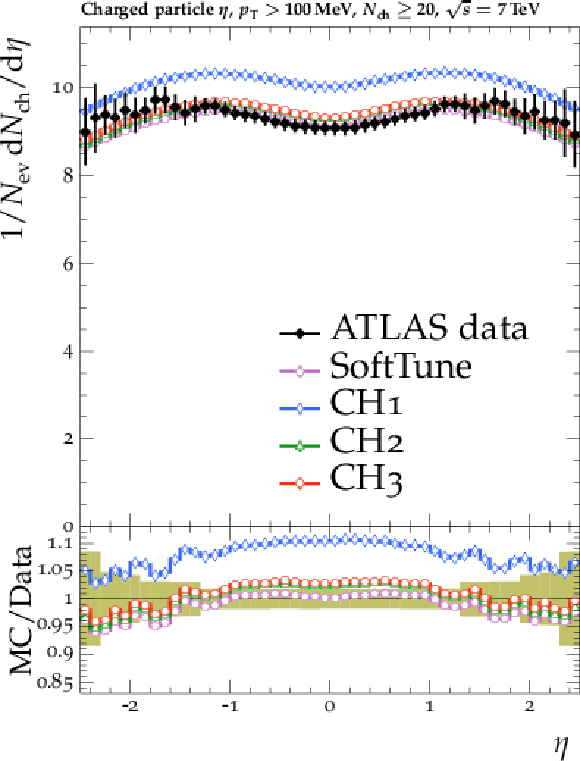
png pdf |
Figure 21-d:
Normalized plots [48] for the pseudorapidity of charged particles for $ {N_{\mathrm{CH}}} \ge $ 1 (upper left), and $ {N_{\mathrm{CH}}} \ge $ 6 (lower left), for charged particles with $ {p_{\mathrm {T}}} > $ 500 MeV. The figure on the upper right shows a similar distribution for $ {N_{\mathrm{CH}}} \ge $ 2, and the lower right for $ {N_{\mathrm{CH}}} \ge $ 20, where the charged particles have $ {p_{\mathrm {T}}} > $ 100 MeV. ATLAS MB data are compared with the predictions from HERWIG 7, with the SoftTune and CH tunes. The coloured band in the ratio plot represents the total experimental uncertainty in the data. The vertical bars on the points for the different predictions represent the statistical uncertainties. |
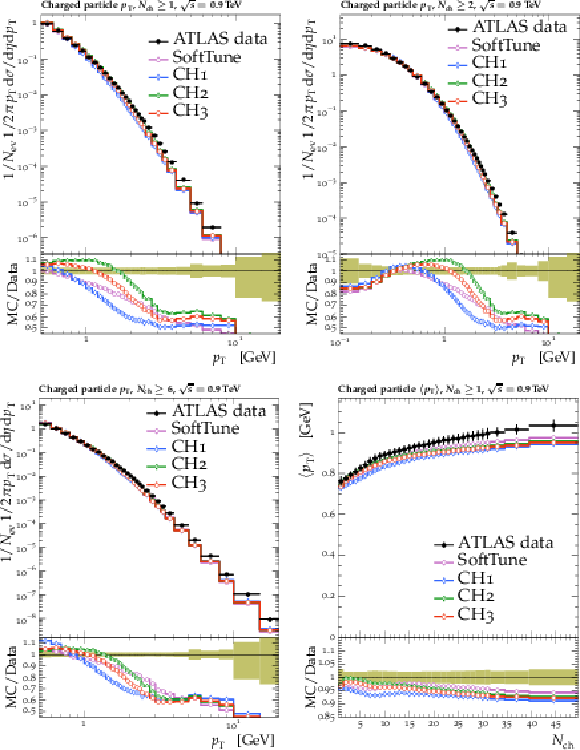
png pdf |
Figure 22:
Normalized plots [48] for the charged-particle ${p_{\mathrm {T}}}$ for $ {N_{\mathrm{CH}}} \ge $ 1 (upper left), $ {N_{\mathrm{CH}}} \ge $ 2 (upper right), and $ {N_{\mathrm{CH}}} \ge $ 6 (lower left). The mean charged-particle ${p_{\mathrm {T}}}$ as a function of the charged-particle multiplicity is also shown (lower right). ATLAS MB data are compared with the predictions from HERWIG 7, with the SoftTune and CH tunes. The coloured band in the ratio plot represents the total experimental uncertainty in the data. The vertical bars on the points for the different predictions represent the statistical uncertainties. |

png pdf |
Figure 22-a:
Normalized plots [48] for the charged-particle ${p_{\mathrm {T}}}$ for $ {N_{\mathrm{CH}}} \ge $ 1 (upper left), $ {N_{\mathrm{CH}}} \ge $ 2 (upper right), and $ {N_{\mathrm{CH}}} \ge $ 6 (lower left). The mean charged-particle ${p_{\mathrm {T}}}$ as a function of the charged-particle multiplicity is also shown (lower right). ATLAS MB data are compared with the predictions from HERWIG 7, with the SoftTune and CH tunes. The coloured band in the ratio plot represents the total experimental uncertainty in the data. The vertical bars on the points for the different predictions represent the statistical uncertainties. |

png pdf |
Figure 22-b:
Normalized plots [48] for the charged-particle ${p_{\mathrm {T}}}$ for $ {N_{\mathrm{CH}}} \ge $ 1 (upper left), $ {N_{\mathrm{CH}}} \ge $ 2 (upper right), and $ {N_{\mathrm{CH}}} \ge $ 6 (lower left). The mean charged-particle ${p_{\mathrm {T}}}$ as a function of the charged-particle multiplicity is also shown (lower right). ATLAS MB data are compared with the predictions from HERWIG 7, with the SoftTune and CH tunes. The coloured band in the ratio plot represents the total experimental uncertainty in the data. The vertical bars on the points for the different predictions represent the statistical uncertainties. |
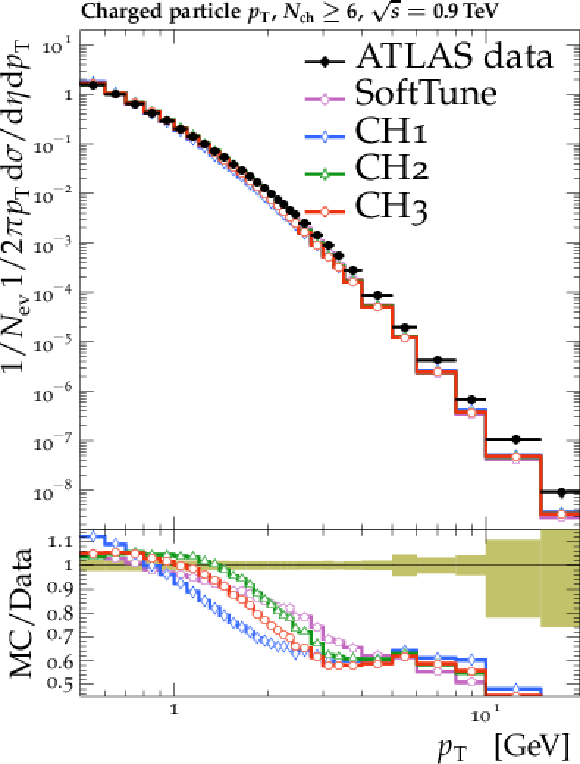
png pdf |
Figure 22-c:
Normalized plots [48] for the charged-particle ${p_{\mathrm {T}}}$ for $ {N_{\mathrm{CH}}} \ge $ 1 (upper left), $ {N_{\mathrm{CH}}} \ge $ 2 (upper right), and $ {N_{\mathrm{CH}}} \ge $ 6 (lower left). The mean charged-particle ${p_{\mathrm {T}}}$ as a function of the charged-particle multiplicity is also shown (lower right). ATLAS MB data are compared with the predictions from HERWIG 7, with the SoftTune and CH tunes. The coloured band in the ratio plot represents the total experimental uncertainty in the data. The vertical bars on the points for the different predictions represent the statistical uncertainties. |
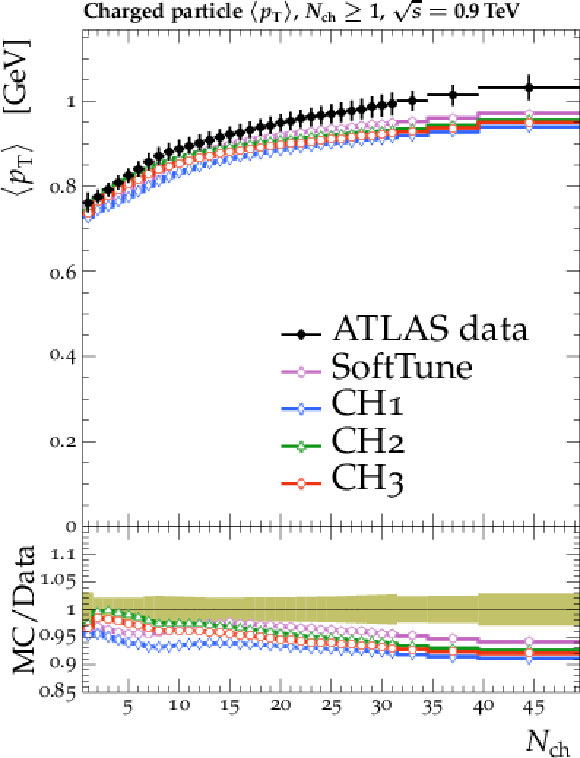
png pdf |
Figure 22-d:
Normalized plots [48] for the charged-particle ${p_{\mathrm {T}}}$ for $ {N_{\mathrm{CH}}} \ge $ 1 (upper left), $ {N_{\mathrm{CH}}} \ge $ 2 (upper right), and $ {N_{\mathrm{CH}}} \ge $ 6 (lower left). The mean charged-particle ${p_{\mathrm {T}}}$ as a function of the charged-particle multiplicity is also shown (lower right). ATLAS MB data are compared with the predictions from HERWIG 7, with the SoftTune and CH tunes. The coloured band in the ratio plot represents the total experimental uncertainty in the data. The vertical bars on the points for the different predictions represent the statistical uncertainties. |

png pdf |
Figure 23:
Normalized plots [48] for the charged-particle ${p_{\mathrm {T}}}$ for $ {N_{\mathrm{CH}}} \ge $ 1 (upper left), $ {N_{\mathrm{CH}}} \ge $ 2 (upper right), and $ {N_{\mathrm{CH}}} \ge $ 6 (lower left). The mean charged-particle ${p_{\mathrm {T}}}$ as a function of the charged-particle multiplicity is also shown (lower right). ATLAS MB data are compared with the predictions from HERWIG 7, with the SoftTune and CH tunes. The coloured band in the ratio plot represents the total experimental uncertainty in the data. The vertical bars on the points for the different predictions represent the statistical uncertainties. |

png pdf |
Figure 23-a:
Normalized plots [48] for the charged-particle ${p_{\mathrm {T}}}$ for $ {N_{\mathrm{CH}}} \ge $ 1 (upper left), $ {N_{\mathrm{CH}}} \ge $ 2 (upper right), and $ {N_{\mathrm{CH}}} \ge $ 6 (lower left). The mean charged-particle ${p_{\mathrm {T}}}$ as a function of the charged-particle multiplicity is also shown (lower right). ATLAS MB data are compared with the predictions from HERWIG 7, with the SoftTune and CH tunes. The coloured band in the ratio plot represents the total experimental uncertainty in the data. The vertical bars on the points for the different predictions represent the statistical uncertainties. |
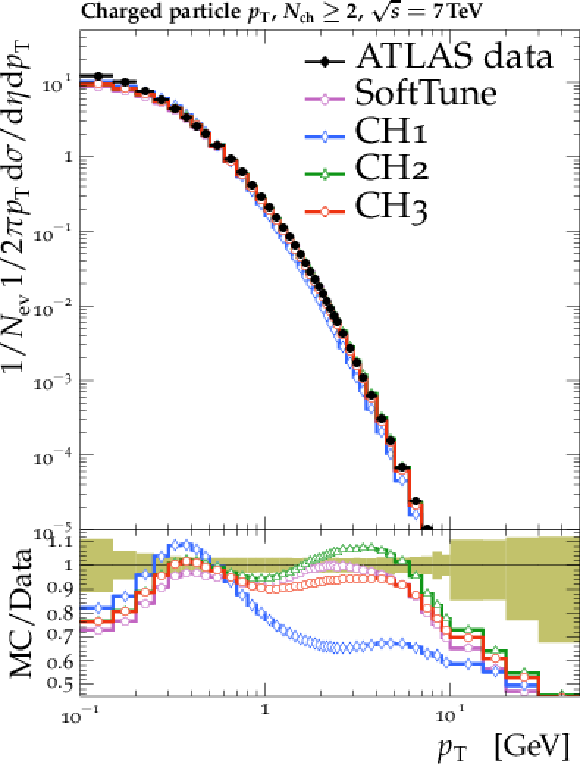
png pdf |
Figure 23-b:
Normalized plots [48] for the charged-particle ${p_{\mathrm {T}}}$ for $ {N_{\mathrm{CH}}} \ge $ 1 (upper left), $ {N_{\mathrm{CH}}} \ge $ 2 (upper right), and $ {N_{\mathrm{CH}}} \ge $ 6 (lower left). The mean charged-particle ${p_{\mathrm {T}}}$ as a function of the charged-particle multiplicity is also shown (lower right). ATLAS MB data are compared with the predictions from HERWIG 7, with the SoftTune and CH tunes. The coloured band in the ratio plot represents the total experimental uncertainty in the data. The vertical bars on the points for the different predictions represent the statistical uncertainties. |

png pdf |
Figure 23-c:
Normalized plots [48] for the charged-particle ${p_{\mathrm {T}}}$ for $ {N_{\mathrm{CH}}} \ge $ 1 (upper left), $ {N_{\mathrm{CH}}} \ge $ 2 (upper right), and $ {N_{\mathrm{CH}}} \ge $ 6 (lower left). The mean charged-particle ${p_{\mathrm {T}}}$ as a function of the charged-particle multiplicity is also shown (lower right). ATLAS MB data are compared with the predictions from HERWIG 7, with the SoftTune and CH tunes. The coloured band in the ratio plot represents the total experimental uncertainty in the data. The vertical bars on the points for the different predictions represent the statistical uncertainties. |

png pdf |
Figure 23-d:
Normalized plots [48] for the charged-particle ${p_{\mathrm {T}}}$ for $ {N_{\mathrm{CH}}} \ge $ 1 (upper left), $ {N_{\mathrm{CH}}} \ge $ 2 (upper right), and $ {N_{\mathrm{CH}}} \ge $ 6 (lower left). The mean charged-particle ${p_{\mathrm {T}}}$ as a function of the charged-particle multiplicity is also shown (lower right). ATLAS MB data are compared with the predictions from HERWIG 7, with the SoftTune and CH tunes. The coloured band in the ratio plot represents the total experimental uncertainty in the data. The vertical bars on the points for the different predictions represent the statistical uncertainties. |
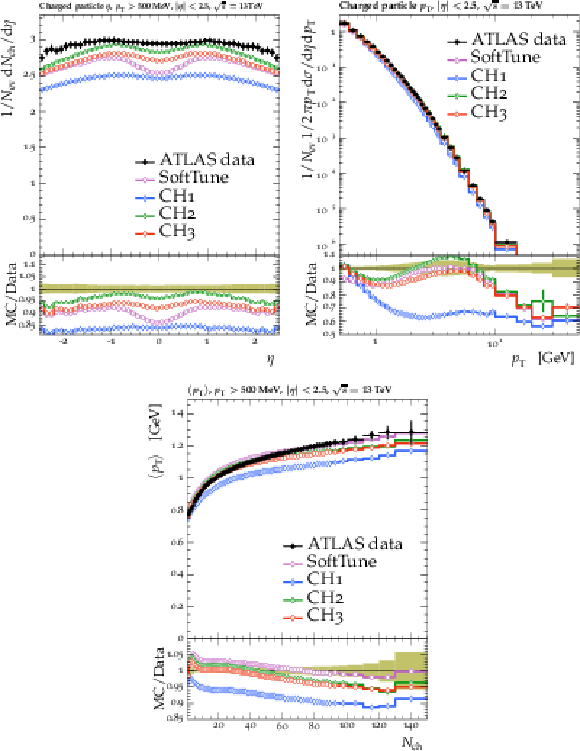
png pdf |
Figure 24:
Normalized plots [49] for the pseudorapidity of charged particles (upper left), charged-particle ${p_{\mathrm {T}}}$ distribution (upper left), and the mean charged-particle ${p_{\mathrm {T}}}$ distribution as a function of the charged-particle multiplicity (lower), all for $ {| \eta |} < $ 2.5. ATLAS MB data are compared with the predictions from HERWIG 7, with the SoftTune and CH tunes. The coloured band in the ratio plot represents the total experimental uncertainty in the data. The vertical bars on the points for the different predictions represent the statistical uncertainties. |

png pdf |
Figure 24-a:
Normalized plots [49] for the pseudorapidity of charged particles (upper left), charged-particle ${p_{\mathrm {T}}}$ distribution (upper left), and the mean charged-particle ${p_{\mathrm {T}}}$ distribution as a function of the charged-particle multiplicity (lower), all for $ {| \eta |} < $ 2.5. ATLAS MB data are compared with the predictions from HERWIG 7, with the SoftTune and CH tunes. The coloured band in the ratio plot represents the total experimental uncertainty in the data. The vertical bars on the points for the different predictions represent the statistical uncertainties. |
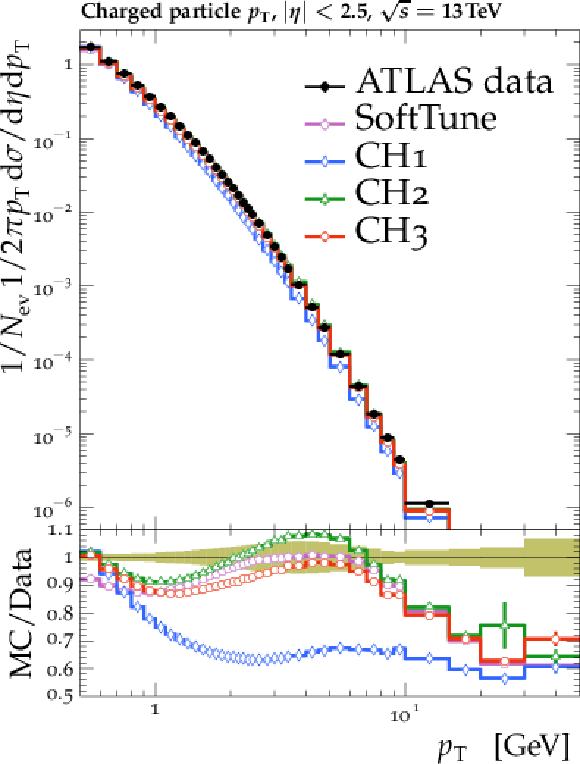
png pdf |
Figure 24-b:
Normalized plots [49] for the pseudorapidity of charged particles (upper left), charged-particle ${p_{\mathrm {T}}}$ distribution (upper left), and the mean charged-particle ${p_{\mathrm {T}}}$ distribution as a function of the charged-particle multiplicity (lower), all for $ {| \eta |} < $ 2.5. ATLAS MB data are compared with the predictions from HERWIG 7, with the SoftTune and CH tunes. The coloured band in the ratio plot represents the total experimental uncertainty in the data. The vertical bars on the points for the different predictions represent the statistical uncertainties. |
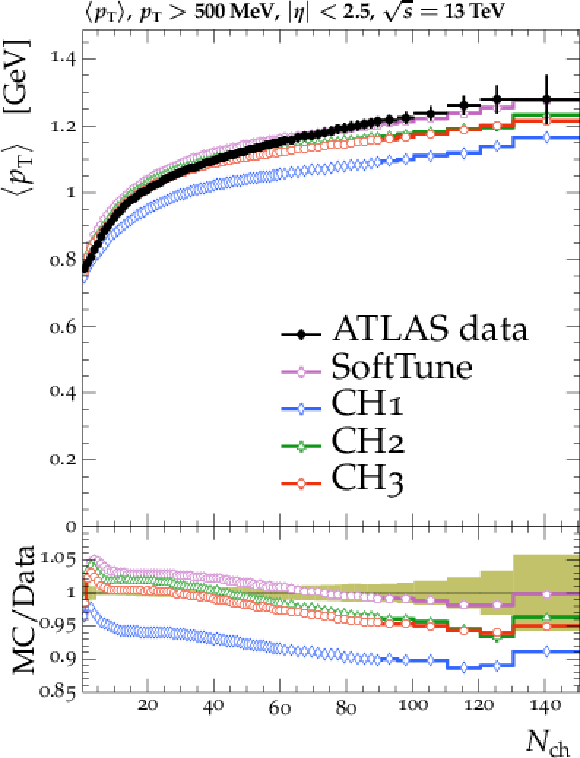
png pdf |
Figure 24-c:
Normalized plots [49] for the pseudorapidity of charged particles (upper left), charged-particle ${p_{\mathrm {T}}}$ distribution (upper left), and the mean charged-particle ${p_{\mathrm {T}}}$ distribution as a function of the charged-particle multiplicity (lower), all for $ {| \eta |} < $ 2.5. ATLAS MB data are compared with the predictions from HERWIG 7, with the SoftTune and CH tunes. The coloured band in the ratio plot represents the total experimental uncertainty in the data. The vertical bars on the points for the different predictions represent the statistical uncertainties. |

png pdf |
Figure 25:
Normalized plots [49] for the pseudorapidity of charged particles (upper left), charged-particle ${p_{\mathrm {T}}}$ distribution (upper left), and the mean charged-particle ${p_{\mathrm {T}}}$ distribution as a function of the charged-particle multiplicity (lower), all for $ {| \eta |} < $ 0.8. ATLAS MB data are compared with the predictions from HERWIG 7, with the SoftTune and CH tunes. The coloured band in the ratio plot represents the total experimental uncertainty in the data. The vertical bars on the points for the different predictions represent the statistical uncertainties. |

png pdf |
Figure 25-a:
Normalized plots [49] for the pseudorapidity of charged particles (upper left), charged-particle ${p_{\mathrm {T}}}$ distribution (upper left), and the mean charged-particle ${p_{\mathrm {T}}}$ distribution as a function of the charged-particle multiplicity (lower), all for $ {| \eta |} < $ 0.8. ATLAS MB data are compared with the predictions from HERWIG 7, with the SoftTune and CH tunes. The coloured band in the ratio plot represents the total experimental uncertainty in the data. The vertical bars on the points for the different predictions represent the statistical uncertainties. |
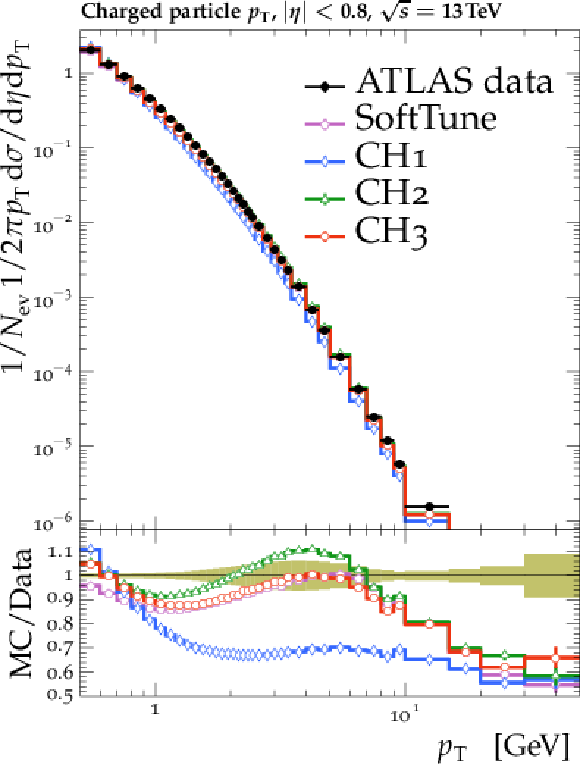
png pdf |
Figure 25-b:
Normalized plots [49] for the pseudorapidity of charged particles (upper left), charged-particle ${p_{\mathrm {T}}}$ distribution (upper left), and the mean charged-particle ${p_{\mathrm {T}}}$ distribution as a function of the charged-particle multiplicity (lower), all for $ {| \eta |} < $ 0.8. ATLAS MB data are compared with the predictions from HERWIG 7, with the SoftTune and CH tunes. The coloured band in the ratio plot represents the total experimental uncertainty in the data. The vertical bars on the points for the different predictions represent the statistical uncertainties. |

png pdf |
Figure 25-c:
Normalized plots [49] for the pseudorapidity of charged particles (upper left), charged-particle ${p_{\mathrm {T}}}$ distribution (upper left), and the mean charged-particle ${p_{\mathrm {T}}}$ distribution as a function of the charged-particle multiplicity (lower), all for $ {| \eta |} < $ 0.8. ATLAS MB data are compared with the predictions from HERWIG 7, with the SoftTune and CH tunes. The coloured band in the ratio plot represents the total experimental uncertainty in the data. The vertical bars on the points for the different predictions represent the statistical uncertainties. |
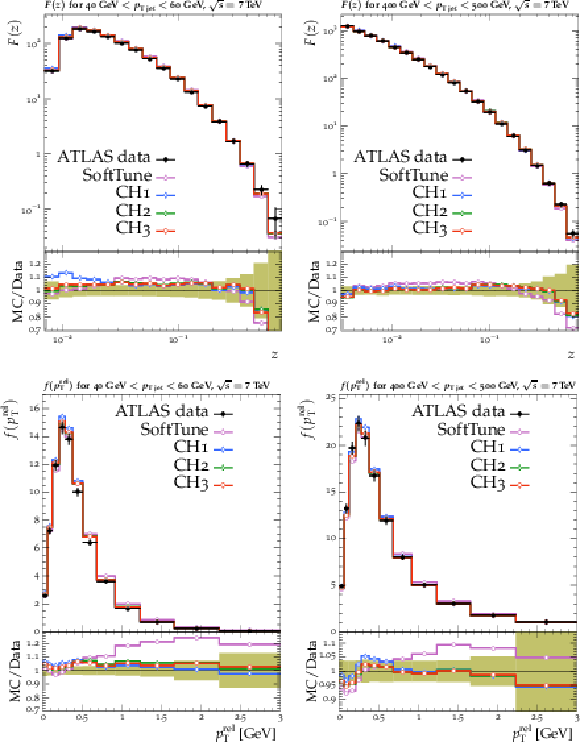
png pdf |
Figure 26:
The ATLAS data at $ {\sqrt {s}} = $ 7 TeV on the ${F(z)}$ and ${f({p_{\mathrm {T}}} ^{\mathrm {rel}}})$ distributions [17]. ATLAS inclusive jet data are compared with the predictions from HERWIG 7, with the SoftTune and CH tunes. The coloured band in the ratio plot represents the total experimental uncertainty in the data. The vertical bars on the points for the different predictions represent the statistical uncertainties. |

png pdf |
Figure 26-a:
The ATLAS data at $ {\sqrt {s}} = $ 7 TeV on the ${F(z)}$ and ${f({p_{\mathrm {T}}} ^{\mathrm {rel}}})$ distributions [17]. ATLAS inclusive jet data are compared with the predictions from HERWIG 7, with the SoftTune and CH tunes. The coloured band in the ratio plot represents the total experimental uncertainty in the data. The vertical bars on the points for the different predictions represent the statistical uncertainties. |

png pdf |
Figure 26-b:
The ATLAS data at $ {\sqrt {s}} = $ 7 TeV on the ${F(z)}$ and ${f({p_{\mathrm {T}}} ^{\mathrm {rel}}})$ distributions [17]. ATLAS inclusive jet data are compared with the predictions from HERWIG 7, with the SoftTune and CH tunes. The coloured band in the ratio plot represents the total experimental uncertainty in the data. The vertical bars on the points for the different predictions represent the statistical uncertainties. |
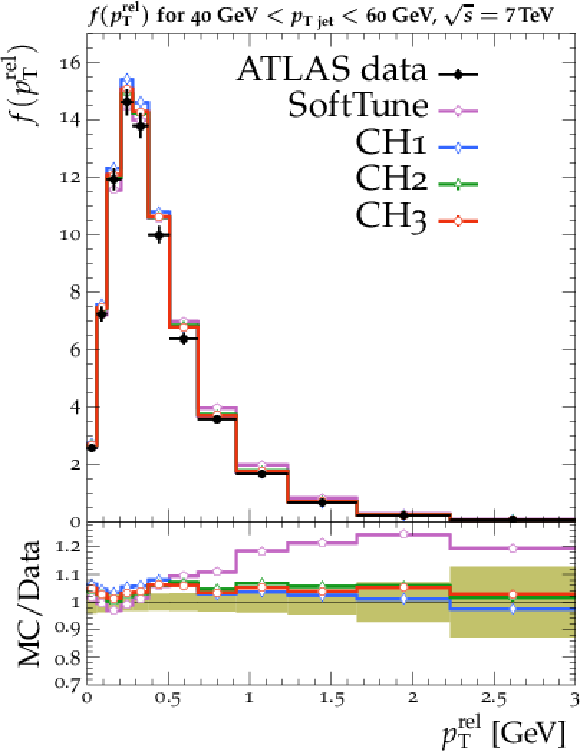
png pdf |
Figure 26-c:
The ATLAS data at $ {\sqrt {s}} = $ 7 TeV on the ${F(z)}$ and ${f({p_{\mathrm {T}}} ^{\mathrm {rel}}})$ distributions [17]. ATLAS inclusive jet data are compared with the predictions from HERWIG 7, with the SoftTune and CH tunes. The coloured band in the ratio plot represents the total experimental uncertainty in the data. The vertical bars on the points for the different predictions represent the statistical uncertainties. |
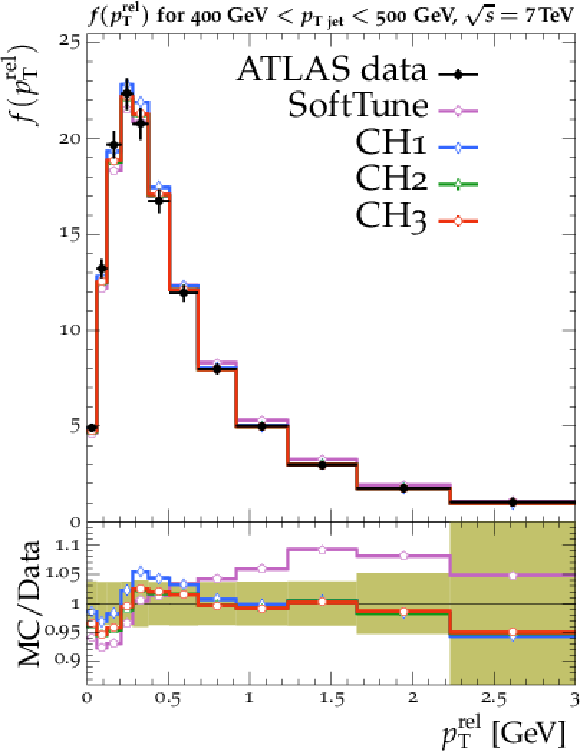
png pdf |
Figure 26-d:
The ATLAS data at $ {\sqrt {s}} = $ 7 TeV on the ${F(z)}$ and ${f({p_{\mathrm {T}}} ^{\mathrm {rel}}})$ distributions [17]. ATLAS inclusive jet data are compared with the predictions from HERWIG 7, with the SoftTune and CH tunes. The coloured band in the ratio plot represents the total experimental uncertainty in the data. The vertical bars on the points for the different predictions represent the statistical uncertainties. |
| Tables | |

png pdf |
Table 1:
Parameters considered in the tuning, and their allowed ranges in the fit. |

png pdf |
Table 2:
Value of the parameters for the SoftTune [12,3], CH1, CH2, and CH3 tunes. |
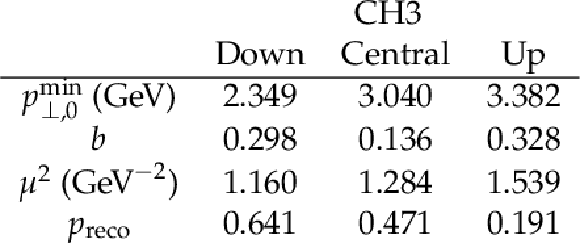
png pdf |
Table 3:
Parameters of the central, "up'', and "down'' variations of the CH3 tune. |
| Summary |
|
Three new tunes for the multiple-parton interaction (MPI) model of the HERWIG 7 (version 7.1.4) generator have been derived from minimum-bias (MB) data collected by the CMS experiment. All of the CH ("CMS HERWIG'') tunes, CH1, CH2, and CH3, are based on the next-to-next-to-leading-order (NNLO) NNPDF 3.1 PDF set for the simulation of the parton shower (PS) in HERWIG 7; the value of the strong coupling at a scale equal to the Z boson mass is ${\alpha_S}(m_{\mathrm{Z}})=$ 0.118 with a two-loop evolution of ${\alpha_S}$. The configuration of the tunes differs in the PDF used for the simulation of MPI and beam remnants. The tune CH1 uses the same NNLO PDF set for these aspects of the HERWIG 7 simulation, whereas CH2 and CH3 use leading-order (LO) versions of the PDF set. The tune CH2 is based on an LO PDF set that was derived assuming ${\alpha_S}(m_{\mathrm{Z}})=$ 0.118, and CH3 on an LO PDF set assuming ${\alpha_S}(m_{\mathrm{Z}})=$ 0.130. The parameters of the MPI model were optimized for each tune with the PROFESSOR framework to describe the underlying event (UE) in MB data collected by CMS. The predictions using the tune CH2 or CH3 provide a better description of the data than those using CH1 or SoftTune. Furthermore, the differences in the predictions of CH2 and CH3 are observed to be small. The configuration of PDF sets in the tune CH3, where the LO PDF used for the simulation of MPI, was derived with a value of ${\alpha_S}(m_{\mathrm{Z}})$ typically associated with LO PDF sets, is the preferred choice over CH2. Two alternative tunes representing the uncertainties in the fitted parameters of CH3 are also derived, based on the tuning procedure provided by PROFESSOR. Predictions using the three CH tunes are compared with a range of data beyond MB events: event shape data from LEP; proton-proton data enriched in top quark pairs, Z bosons and W bosons; and inclusive jet data. This validated the performance of HERWIG 7 using these tunes against a wide range of data sets sensitive to various aspects of the modelling by HERWIG 7, and in particular the modelling of the UE. The event shape observables measured at LEP, which are sensitive to the modelling of final-state radiation, are well described by HERWIG 7 with the new tunes. Predictions using the new tunes are also shown to describe the UE in events containing Z bosons, demonstrating the universality of the UE modelling in HERWIG 7. The kinematics of top quark events, and the modelling of jets in $\mathrm{t\bar{t}}$, Z boson, W boson, and inclusive jet data are also well described by predictions using the new tunes. In general, predictions with the new CH tunes derived in this paper provide a better description of measured observables than those using SoftTune, the default tune available in HERWIG 7. |
| References | ||||
| 1 | M. Bahr et al. | HERWIG++ physics and manual | EPJC 58 (2008) 639 | 0803.0883 |
| 2 | J. Bellm et al. | HERWIG 7.0/HERWIG++ 3.0 release note | EPJC 76 (2016) 196 | 1512.01178 |
| 3 | J. Bellm et al. | Herwig 7.1 release note | 1705.06919 | |
| 4 | T. Sjostrand et al. | An introduction to PYTHIA 8.2 | CPC 191 (2015) 159 | 1410.3012 |
| 5 | S. Platzer and S. Gieseke | Dipole showers and automated NLO matching in HERWIG++ | EPJC 72 (2012) 2187 | 1109.6256 |
| 6 | P. Nason | A new method for combining NLO QCD with shower Monte Carlo algorithms | JHEP 11 (2004) 040 | hep-ph/0409146 |
| 7 | S. Frixione, P. Nason, and C. Oleari | Matching NLO QCD computations with parton shower simulations: the POWHEG method | JHEP 11 (2007) 070 | 0709.2092 |
| 8 | S. Alioli, P. Nason, C. Oleari, and E. Re | A general framework for implementing NLO calculations in shower Monte Carlo programs: the POWHEG BOX | JHEP 06 (2010) 043 | 1002.2581 |
| 9 | J. Alwall et al. | The automated computation of tree-level and next-to-leading order differential cross sections, and their matching to parton shower simulations | JHEP 07 (2014) 079 | 1405.0301 |
| 10 | G. Corcella et al. | HERWIG 6: An event generator for hadron emission reactions with interfering gluons (including supersymmetric processes) | JHEP 01 (2001) 010 | hep-ph/0011363 |
| 11 | M. Bahr, S. Gieseke, and M. H. Seymour | Simulation of multiple partonic interactions in HERWIG++ | JHEP 07 (2008) 076 | 0803.3633 |
| 12 | S. Gieseke, F. Loshaj, and P. Kirchgaeßer | Soft and diffractive scattering with the cluster model in HERWIG | EPJC 77 (2017) 156 | 1612.04701 |
| 13 | S. Gieseke, C. Rohr, and A. Siodmok | Colour reconnections in HERWIG++ | EPJC 72 (2012) 2225 | 1206.0041 |
| 14 | ATLAS Collaboration | Rapidity gap cross sections measured with the ATLAS detector in pp collisions at $ \sqrt{s}= $ 7 TeV | EPJC 72 (2012) 1926 | 1201.2808 |
| 15 | CMS Collaboration | Measurement of diffraction dissociation cross sections in pp collisions at $ \sqrt{s} = $ 7 TeV | PRD 92 (2015) 012003 | CMS-FSQ-12-005 1503.08689 |
| 16 | L. A. Harland-Lang, A. D. Martin, P. Motylinski, and R. S. Thorne | Parton distributions in the LHC era: MMHT 2014 PDFs | EPJC 75 (2015) 204 | 1412.3989 |
| 17 | ATLAS Collaboration | Measurement of the jet fragmentation function and transverse profile in proton-proton collisions at a center-of-mass energy of 7 TeV with the ATLAS detector | EPJC 71 (2011) 1795 | 1109.5816 |
| 18 | NNPDF Collaboration | Parton distributions from high-precision collider data | EPJC 77 (2017) 663 | 1706.00428 |
| 19 | CMS Collaboration | Extraction and validation of a new set of CMS PYTHIA 8 tunes from underlying-event measurements | EPJC 80 (2020) 4 | CMS-GEN-17-001 1903.12179 |
| 20 | CMS Collaboration | The CMS experiment at the CERN LHC | JINST 3 (2008) S08004 | CMS-00-001 |
| 21 | B. R. Webber | A QCD model for jet fragmentation including soft gluon interference | NPB 238 (1984) 492 | |
| 22 | A. Buckley et al. | Rivet user manual | CPC 184 (2013) 2803 | 1003.0694 |
| 23 | CMS Collaboration | Measurement of the underlying event activity at the LHC at 7 TeV and comparison with 0.9 TeV | CMS-PAS-FSQ-12-020 | |
| 24 | CMS Collaboration | Underlying event measurements with leading particles and jets in pp collisions at $ \sqrt{s} = $ 13 TeV | CMS-PAS-FSQ-15-007 | CMS-PAS-FSQ-15-007 |
| 25 | CMS Collaboration | Measurement of the underlying event activity at the LHC with $ \sqrt{s}= $ 7 TeV and comparison with $ \sqrt{s} = $ 0.9 TeV | JHEP 09 (2011) 109 | CMS-QCD-10-010 1107.0330 |
| 26 | M. Cacciari and G. P. Salam | Dispelling the $ N^{3} $ myth for the $ {k_{\mathrm{T}}} $ jet-finder | PLB 641 (2006) 57 | hep-ph/0512210 |
| 27 | CMS Collaboration | Pseudorapidity distribution of charged hadrons in proton-proton collisions at $ \sqrt{s} = $ 13 TeV | PLB 751 (2015) 143 | CMS-FSQ-15-001 1507.05915 |
| 28 | CMS Collaboration | Transverse-momentum and pseudorapidity distributions of charged hadrons in pp collisions at $ \sqrt{s}= $ 7 TeV | PRL 105 (2010) 022002 | CMS-QCD-10-006 1005.3299 |
| 29 | T. Sjostrand, S. Mrenna, and P. Z. Skands | PYTHIA 6.4 physics and manual | JHEP 05 (2006) 026 | hep-ph/0603175 |
| 30 | A. Buckley et al. | Systematic event generator tuning for the LHC | EPJC 65 (2010) 331 | 0907.2973 |
| 31 | CDF Collaboration | Study of the energy dependence of the underlying event in proton-antiproton collisions | PRD 92 (2015) 092009 | 1508.05340 |
| 32 | ALEPH Collaboration | Studies of QCD at e+e- centre-of-mass energies between 91 GeV and 209 GeV | EPJC 35 (2004) 457 | |
| 33 | S. Catani, B. R. Webber, and G. Marchesini | QCD coherent branching and semi-inclusive processes at large x | NPB 349 (1991) 635 | |
| 34 | D. Reichelt, P. Richardson, and A. Siodmok | Improving the simulation of quark and gluon jets with HERWIG 7 | EPJC 77 (2017) 876 | 1708.01491 |
| 35 | S. Frixione, P. Nason, and G. Ridolfi | A positive-weight next-to-leading-order Monte Carlo for heavy flavour hadroproduction | JHEP 09 (2007) 126 | 0707.3088 |
| 36 | CMS Collaboration | Investigations of the impact of the parton shower tuning in PYTHIA 8 in the modelling of $ \mathrm{t\overline{t}} $ at $ \sqrt{s}= $ 8 and 13 TeV | CMS-PAS-TOP-16-021 | CMS-PAS-TOP-16-021 |
| 37 | B. Cooper et al. | Importance of a consistent choice of $ \alpha_\mathrm{S} $ in the matching of AlpGen and PYTHIA | EPJC 72 (2012) 2078 | 1109.5295 |
| 38 | CMS Collaboration | Measurement of differential cross sections for the production of top quark pairs and of additional jets in lepton+jets events from pp collisions at $ \sqrt{s} = $ 13 ~TeV | PRD 97 (2018) 112003 | CMS-TOP-17-002 1803.08856 |
| 39 | M. Cacciari, G. P. Salam, and G. Soyez | The anti-$ {k_{\mathrm{T}}} $ jet clustering algorithm | JHEP 04 (2008) 063 | 0802.1189 |
| 40 | M. Cacciari, G. P. Salam, and G. Soyez | FastJet user manual | EPJC 72 (2012) 1896 | 1111.6097 |
| 41 | CMS Collaboration | Measurements of differential cross sections of top quark pair production as a function of kinematic event variables in proton-proton collisions at $ \sqrt{s} = $ 13 ~TeV | JHEP 06 (2018) 002 | CMS-TOP-16-014 1803.03991 |
| 42 | CMS Collaboration | Measurement of jet substructure observables in $ \mathrm{t\overline{t}} $ events from proton-proton collisions at $ \sqrt{s}= $ 13 TeV | PRD 98 (2018) 092014 | CMS-TOP-17-013 1808.07340 |
| 43 | CMS Collaboration | Shape, transverse size, and charged hadron multiplicity of jets in pp collisions at 7 TeV | JHEP 06 (2012) 160 | CMS-QCD-10-029 1204.3170 |
| 44 | R. Frederix and S. Frixione | Merging meets matching in MC@NLO | JHEP 12 (2012) 061 | 1209.6215 |
| 45 | CMS Collaboration | Measurement of the underlying event activity in inclusive Z boson production in proton-proton collisions at $ \sqrt{s}= $ 13 TeV | JHEP 07 (2018) 032 | CMS-FSQ-16-008 1711.04299 |
| 46 | CMS Collaboration | Measurement of differential cross sections for Z boson production in association with jets in proton-proton collisions at $ \sqrt{s} = $ 13 TeV | EPJC 78 (2018) 965 | CMS-SMP-16-015 1804.05252 |
| 47 | CMS Collaboration | Measurement of the differential cross sections for the associated production of a $ W $ boson and jets in proton-proton collisions at $ \sqrt{s}= $ 13 TeV | PRD 96 (2017) 072005 | CMS-SMP-16-005 1707.05979 |
| 48 | ATLAS Collaboration | Charged-particle multiplicities in pp interactions measured with the ATLAS detector at the LHC | New J. Phys. 13 (2011) 053033 | 1012.5104 |
| 49 | ATLAS Collaboration | Charged-particle distributions in $ \sqrt{s} = $ 13 TeV pp interactions measured with the ATLAS detector at the LHC | PLB 758 (2016) 67 | 1602.01633 |

|
Compact Muon Solenoid LHC, CERN |

|

|

|

|

|

|